Mori Nozomi Sushi
11500 W Pico Blvd, Los Angeles, CA 90064
424-273-1146
www.morinozomi.com
Sat 08/31/2024, 07:00p-10:00p
2024's most significant sushi opening thus far has to be that of Mori Nozomi, the eponymous debut restaurant from Chef Nozomi Mori and Akihiro Kanda, which has taken over the Sawtelle home of the longstanding Mori Sushi (no relation). The place launched back in March, and has already began making waves as one of the best new sushi-ya to grace the Southland in a while.
About the Chef: Mori Nozomi (森希望) hails from Amagasaki, Hyogo Prefecture, not far from Osaka, and immigrated to the US in 2017, at age 29. In LA, she initially trained in Japanese tea ceremony (chado) and interestingly, also worked as a model. She eventually applied for a job at Moto Azabu in Marina del Rey (opened in 2016 by Takamichi Arai), and amazingly, it was only then when she began her culinary training. At the start of 2023, Mori worked a brief period at Ginza Onodera, but soon decided that she wanted to venture out on her own. Later that year, she was introduced to Masanori “Maru” Nagano and signed on to take over Mori Sushi, which had just shuttered (it had been operating in a limited capacity since its July 2021 pandemic reopening), and here we are today.
![Mori Nozomi Sushi Bar]()
Here's my view from the rightmost seat at the eight-person sushi bar (which I believe is still the same bar from the Mori Sushi days).
![Mori Nozomi Interior]()
And as we can see, all of the tables have been removed from the dining room, so this is a counter-only affair.
![Mori Nozomi Menu]()
![Mori Nozomi Sake List]()
![Mori Nozomi Sake List]()
![Mori Nozomi Sake List, Seasonal Sake]()
![Mori Nozomi Sparkling Sake, Fruit Sake, Wine List, Beer List, Beverage List]()
![Mori Nozomi Sake by the Glass, Tea Pairing]()
We were provided a printed copy of the night's omakase menu (something I'd like to see more sushi spots implement), which was priced at $250 per person. Also pictured is the restaurant's sake list and small selection of wines, and there's also a tea pairing offered at $59. Corkage is $75 per bottle (wine only). Click for larger versions.
![Place Setting]()
The place setting, replete with a chilled oshibori and a pretty unique chopstick rest.
![2015 Thomas Morey Bâtard-Montrachet]()
![2016 Vincent & Sophie Morey Bâtard-Montrachet]()
We brought along a couple bottles with us, and it was great to be able to enjoy the two expressions of grand cru Burgundy side-by-side:![Chawan mushi with Hokkaido uni and caviar (Lidded)]()
![Chawan mushi with Hokkaido uni and caviar]()
1: Chawan mushi with Hokkaido uni and caviar
Our meal commenced with a series of sakizuke, and up first was this silky, jiggly chawanmushi, sweeter than most at first blush, but with that classic umami goodness coming in later. The cool brine of the sea urchin and salty hits of caviar also worked well to accent the hominess of the egg custard, making for a cozy start overall.
![Matai with Yuzu sauce]()
2: Matai with Yuzu sauce | Red snapper
Slices of red seabream ate super clean, matching up swimmingly with the tanginess of yuzu and even better with those bright, crunchy veggies.
![Buri]()
3: Buri | Kind yellowtail
Japanese amberjack was prepared in a shabu-shabu-like fashion, giving the fish a satisfyingly meaty, rare, slick, half-cooked texture. At the same time, the piquant savor of ponzu and dashi imparted further potency, while the daikon and hana hojiso lightened the mood.
![Ni-tako]()
4: Ni-tako | Hokkaido Octopus
For our nimono course, octopus was simmered for three hours with hojicha, giving it a super tender consistency and some utterly savory, dark-toned flavors. Given the richness of the octo, the yuzukosho served a crucial function as a sour, spicy accent piece.
![Chef Nozomi Mori Shows Off Her Hairy Crab]()
![Horsehair Crab]()
At this point, Nozomi-san brought out a live horsehair crab, which would be utilized in a couple of our later courses.
![Tachiuo tempura, Shirasu kakiage (Covered)]()
![Tachiuo tempura, Shirasu kakiage]()
5: Tachiuo tempura, Shirasu kakiage | Belt fish, whitebait
The last of our zensai brought a trio of tempura. I started with the beltfish, which featured a soft, creamy interior and mild taste that really opened up with a dab of salt. On the other hand, the kaki-age was a whole different story in terms of mouthfeel, and was also more assertive flavor-wise. Last up was the corn, which I found wonderfully sweet, with a delightfully crunchy texture to boot.
![Finger Napkin]()
![Sushi Gari]()
The arrival of a finger napkin and ginger signaled the start of the nigirizushi portion of our meal.
![Bluefin tuna Chu-toro]()
6: Bluefin tuna Chu-toro
Chef Mori kicked things off with a supple slice of savory-sweet chutoro, set atop a pillow of mildly-seasoned, firm-ish rice.
![Bluefin tuna O-toro]()
7: Bluefin tuna O-toro
Kamatoro isn't something you encounter too often around these parts, so it was a treat to see it on the menu tonight. The tuna collar arrived lightly seared, giving the cut a wonderful astringency to offset the sheer richness and fattiness of the fish, and as expected, the shari was crucial for balance. A bit of a showstopper.
![Kasugo-dai]()
8: Kasugo-dai | Baby snapper
Somehow, the kasugodai was much more compelling than most. I loved its cool brine and how that played with the tangy, almost funky nuances present.
![Sanma]()
9: Sanma | Pike mackerel
Rolled mackerel pike had a wonderful smokiness and salinity that was deftly evened out by the citrus and grated daikon.
![Shiro Ika]()
10: Shiro Ika | Swordtip squid
The squid had more depth of flavor than you typically find, which I appreciated, and its tender texture was great when juxtaposed against the relative firmness of Noz-san's rice here.
![Asabiraki 'Kyokusen''極上 旭扇']()
At this point, we'd run out of wine, and thus ordered a bottle of the Asabiraki "Kyokusen""極上 旭扇" [$350]. Coming to us from Morioka in Iwate Prefecture, the junmai daiginjo-class sake displayed some pretty remarkable aromas of anise commingled with banana bubble gum. This was smooth and sweet on the tongue, with notes of flowers and melon fruit backed by countering elements of ricey umami and heat. Lovely.
![Taira-gai]()
11: Taira-gai | Penshell
I'm quite a fan of pen shell, and this was arguably the best I've had. I loved how its considerable sweetness married with the smoky, grassy flavors of the seaweed, while this chili-like heat came in and served as the perfect finishing touch. Excellent texture on the clam, too.
![Hokkaido Kegani]()
12: Hokkaido Kegani | Hairy crab
The horsehair crab from above was served in nigiri form, and revealed this amazingly pure, concentrated sweet salinity that was further boosted by the depth of its kanimiso-based condiment. This was a contender for the best hairy crab I've tasted, a sentiment shared by one of my fellow diners.
![Wild Tsuri-Aji]()
13: Wild Tsuri-Aji | Jack mackerel
A beautifully scored cut of horse mackerel had this slick, semi-firm consistency that I adored, while its super clean, focused, slightly sweet flavors worked seamlessly with the spicy kick of ginger.
![Oshinko]()
14: Oshinko | Japanese pickle
Two types of konomono were then provided: cucumber pickles that reminded me of salted watermelon, and crisp, tangy radishes that worked great as a palate cleanser.
![Hokkaido Uni]()
15: Hokkaido Uni
The sea urchin was on point, its signature sweetness and lingering brine meshing easily with the rice, which was seemingly fuller-flavored in this application.
![Akami]()
16: Akami | Bluefin tuna
Lean tuna married all the delectably umami-laden tastes I was looking for with the sting of wasabi, all while the rice was key in moderating the flavors at play.
![Kegani Ankake]()
17: Kegani Ankake | Hairy crab
Our second presentation of horsehair crab was also a winner, combining the crustacean's sweetness with a viscous, smoky, mouthwateringly savory sauce.
![Akadashi]()
18: Akadashi | Red miso soup
This akamiso-based miso soup was headier and heartier than most, and made for some cozy sipping.
![Nodoguro]()
19: Nodoguro | Blackthroat Seaperch
Given my proclivity for akamutsu, it was great to see it on offer tonight. Served lightly charred, the neta showed off a pleasing temperature contrast, and I was smitten by how well its smoke and sear coalesced with the fish's robust-yet-elegant brine.
![Toro-taku hand roll]()
20: Toro-taku hand roll | Bluefin tuna with Japanese pickle hand roll
The pairing of crisp, sour strips of takuan with fatty tuna is a winning combination indeed, one further enhanced by that saline seaweed wrapper.
![Harujion, Muroka nama genshu, Saga '光栄菊 佐賀県産']()
Our final beverage was the Harujion, Muroka nama genshu, Saga "光栄菊 佐賀県産" [$100], brewed by Koueigiku Shuzo out of Saga Prefecture. The sake leaned bright and spritzy on the nose, with lots of juicy fruit all over the place. I found this slightly effervescent on the palate, its sweet flavors of melon and cotton candy countered by just a touch of earth, making this an easy-drinker for sure.
![Dashimaki Tamago]()
21: Dashimaki Tamago | Japanese omelet
This dashi-infused tamagoyaki was one of the better ones I've tasted in a while. I was of a fan of its supple, somewhat slippery consistency, as well as that layer of umami imparted by the stock.
![Anago]()
22: Anago | Sea eel
Conger eel ate wonderfully soft, sweet, and savory, and served as a fitting end to our parade of sushi.
![Hojicha]()
A roasty cup of hojicha then appeared before us.
![Nodoguro]()
Supplement: Nodoguro [$18.00] | Blackthroat Seaperch
We weren't quite full at this point, so we requested an extra portion of rosy seabass, and its fantastic interplay of smoke and fat was even more apparent this time around.
![Akami]()
Supplement: Akami [$15.00] | Bluefin tuna
This was followed by an extra serving of tuna, which seemed to more keenly emphasize the back-and-forth between soy and wasabi.
![Passion fruit with Hoji-cha crumble]()
23: Passion fruit with Hoji-cha crumble
A refreshing, invigorating passion fruit sorbet was given a nutty, roasty boost from the hojicha crumbles.
![Wagashi with]()
![Kyoto Matcha]()
24: Wagashi with Kyoto Matcha
Our meal concluded a lone confection, sticky to the bite and loaded with sweet black sesame flavors that paired like clockwork with the bitter, grassy nature of green tea.
![Packet of Green Tea]()
A packet of green tea served as our parting gift.
Make no mistake, the sushi at Mori Nozomi was the finest I've had all year, which is a bit remarkable given how relatively new Mori-san is to cooking. I don't think it's a stretch to assume that she's a fast learner. The crux for me is how she was able to infuse her own personality into the food, giving it a certain je ne sais quoi that made the meal stand out from the numerous other omakase options in SoCal. I didn't have any qualms about the service from the Chef and her team (Megumi and Yuko), either, and overall, I must come to the conclusion that this place is a splendid addition to LA's sushi landscape, and a worthy successor to take over this storied address. A must-try for all you sushi aficionados out there.
![2004 Sierra Nevada Bigfoot]()
![2004 Sierra Nevada Celebration Ale]()
Prior to dinner, my dining party convened to enjoy a couple of 20-year-old beers that I had been cellaring, and in general, we were impressed by how well both of 'em held up:
11500 W Pico Blvd, Los Angeles, CA 90064
424-273-1146
www.morinozomi.com
Sat 08/31/2024, 07:00p-10:00p
2024's most significant sushi opening thus far has to be that of Mori Nozomi, the eponymous debut restaurant from Chef Nozomi Mori and Akihiro Kanda, which has taken over the Sawtelle home of the longstanding Mori Sushi (no relation). The place launched back in March, and has already began making waves as one of the best new sushi-ya to grace the Southland in a while.
About the Chef: Mori Nozomi (森希望) hails from Amagasaki, Hyogo Prefecture, not far from Osaka, and immigrated to the US in 2017, at age 29. In LA, she initially trained in Japanese tea ceremony (chado) and interestingly, also worked as a model. She eventually applied for a job at Moto Azabu in Marina del Rey (opened in 2016 by Takamichi Arai), and amazingly, it was only then when she began her culinary training. At the start of 2023, Mori worked a brief period at Ginza Onodera, but soon decided that she wanted to venture out on her own. Later that year, she was introduced to Masanori “Maru” Nagano and signed on to take over Mori Sushi, which had just shuttered (it had been operating in a limited capacity since its July 2021 pandemic reopening), and here we are today.
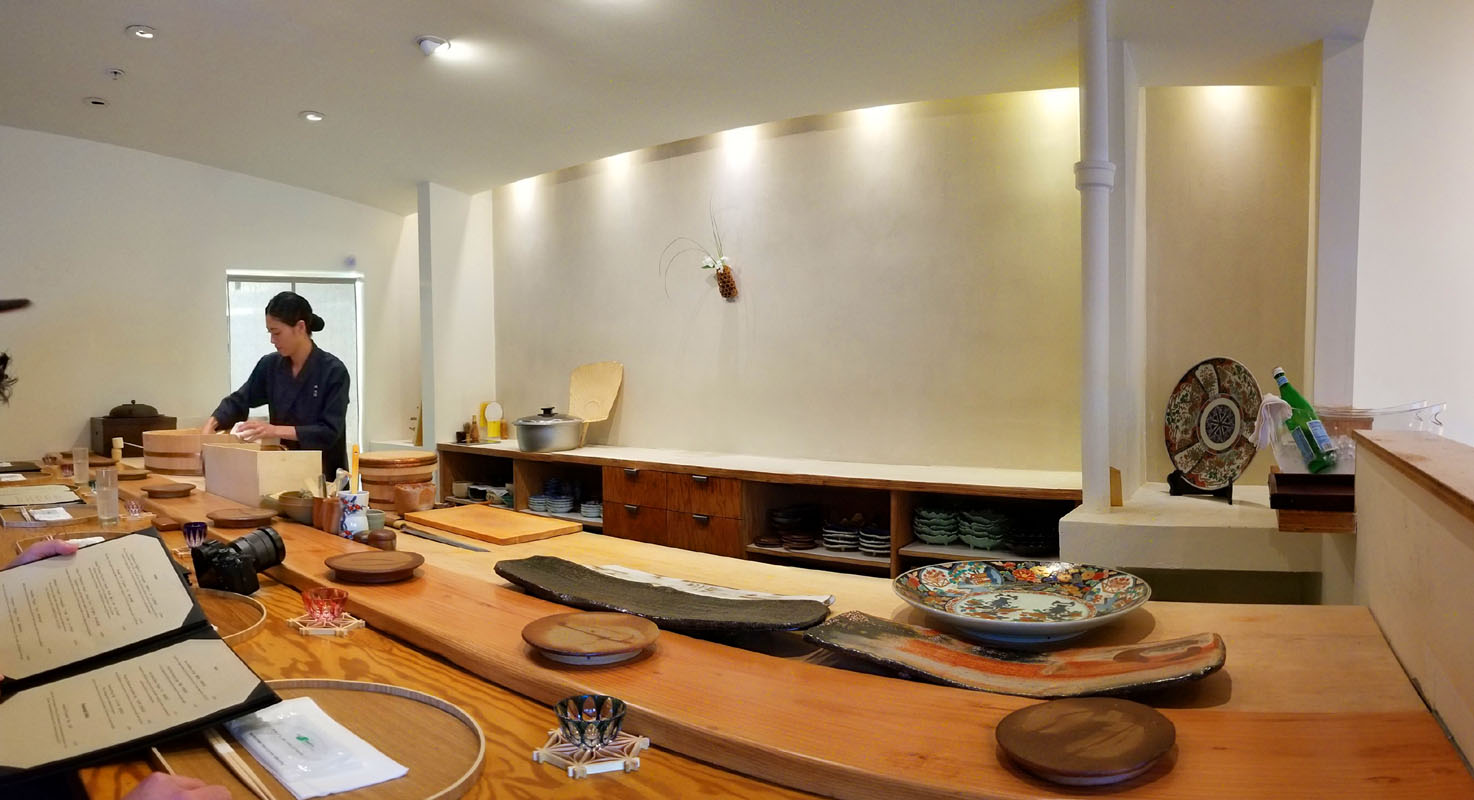
Here's my view from the rightmost seat at the eight-person sushi bar (which I believe is still the same bar from the Mori Sushi days).
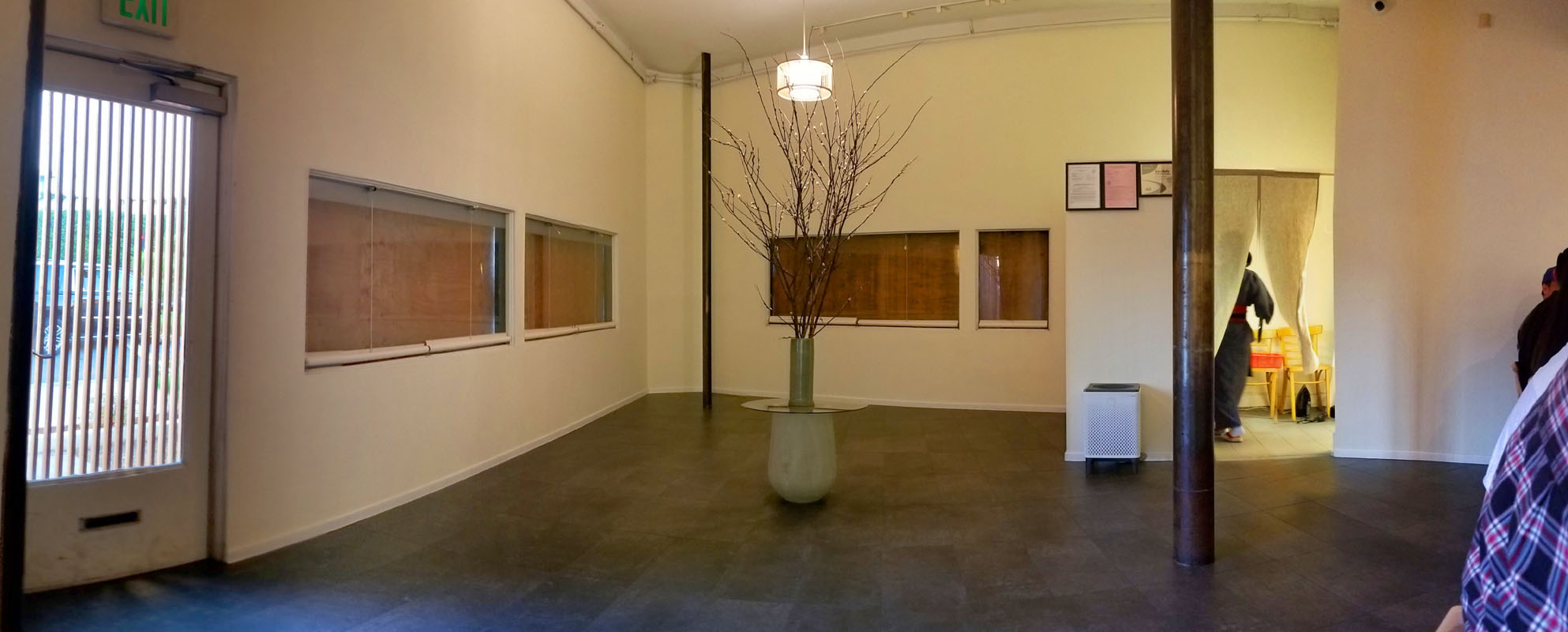
And as we can see, all of the tables have been removed from the dining room, so this is a counter-only affair.
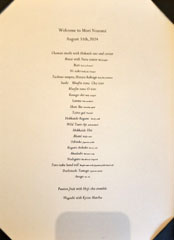
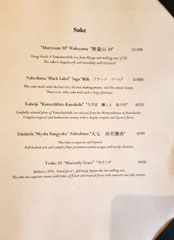
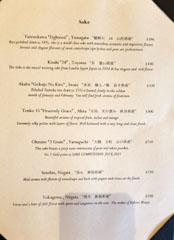
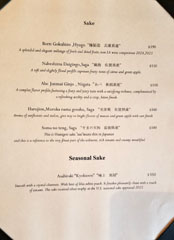
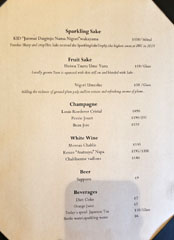
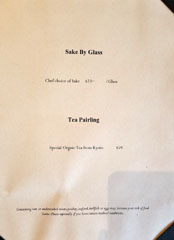
We were provided a printed copy of the night's omakase menu (something I'd like to see more sushi spots implement), which was priced at $250 per person. Also pictured is the restaurant's sake list and small selection of wines, and there's also a tea pairing offered at $59. Corkage is $75 per bottle (wine only). Click for larger versions.

The place setting, replete with a chilled oshibori and a pretty unique chopstick rest.
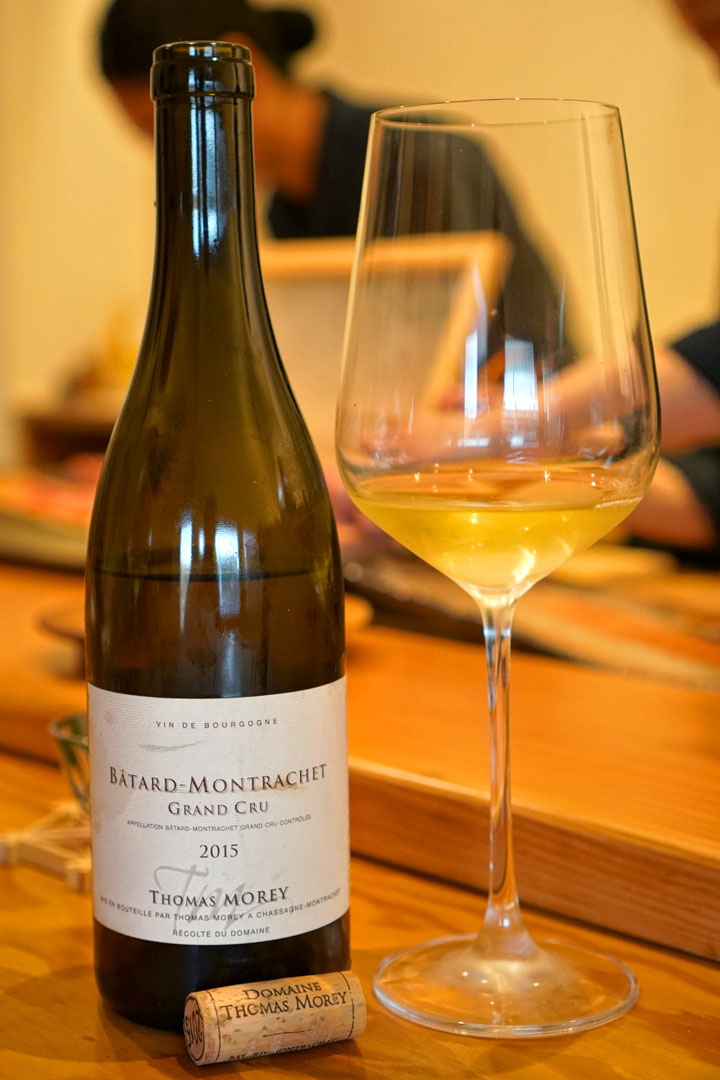

We brought along a couple bottles with us, and it was great to be able to enjoy the two expressions of grand cru Burgundy side-by-side:
- 2015 Thomas Morey Bâtard-Montrachet– I began with the older of the two Burgs. The nose here was rich and heady, with grassiness and funk laced with butter. On the palate, the Bourgogne showcased white fruit and citrus with an almost candied underpinning, balanced by mineral, herb, and a spicy (fennel?) astringency toward the rear to go along with the wine's growing juiciness. With time, the bouquet became unbelievably reminiscent of buttered popcorn, complete with a nutty, smoky component; taste-wise, I got more saline while the fruit veered towards the yellow end of the spectrum. With even more time, the butter subsided, replaced by those yellow fruits, while flavors went in a spicier, grassier direction.
- 2016 Vincent & Sophie Morey Bâtard-Montrachet– Initially, this one demonstrated a brighter, juicier bouquet brimming with citrus, and taste-wise, it was more expressive than the '15, offering up plentiful amounts of luscious orchard fruit, mineral, butter, and herb. My second pour was somehow even juicier on the nose and richer on the palate, conveying potent flavors reminiscent of butterscotch. Pour #3, meanwhile, was roasty in terms of aroma, and also highlighted yellow fruit; taking a sip, I found a softer, rounder presentation dominated by citrus. My final sniffs of the wine showed off a savory depth, and my final sips a muted heat alongside grassy stone fruits.
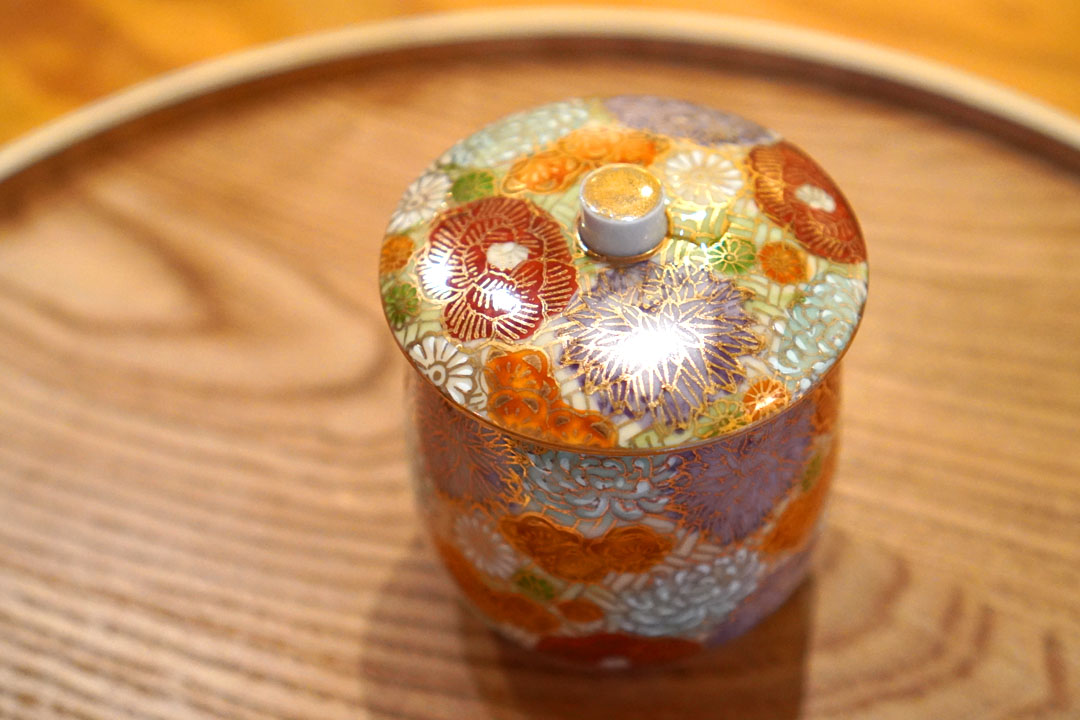
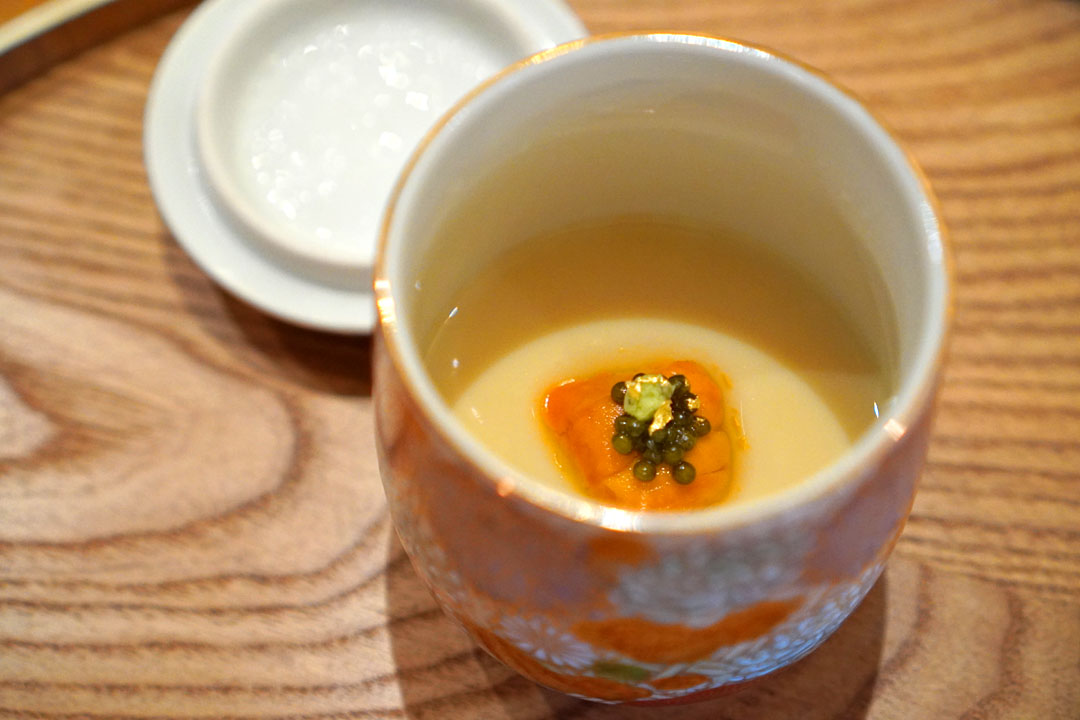
1: Chawan mushi with Hokkaido uni and caviar
Our meal commenced with a series of sakizuke, and up first was this silky, jiggly chawanmushi, sweeter than most at first blush, but with that classic umami goodness coming in later. The cool brine of the sea urchin and salty hits of caviar also worked well to accent the hominess of the egg custard, making for a cozy start overall.
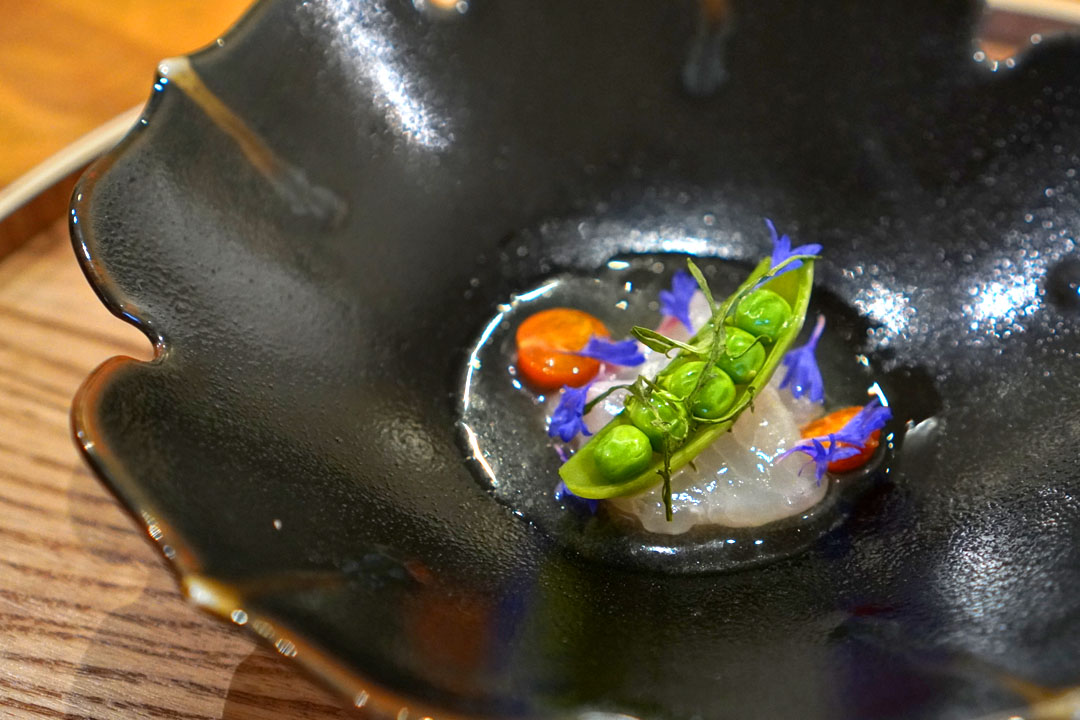
2: Matai with Yuzu sauce | Red snapper
Slices of red seabream ate super clean, matching up swimmingly with the tanginess of yuzu and even better with those bright, crunchy veggies.
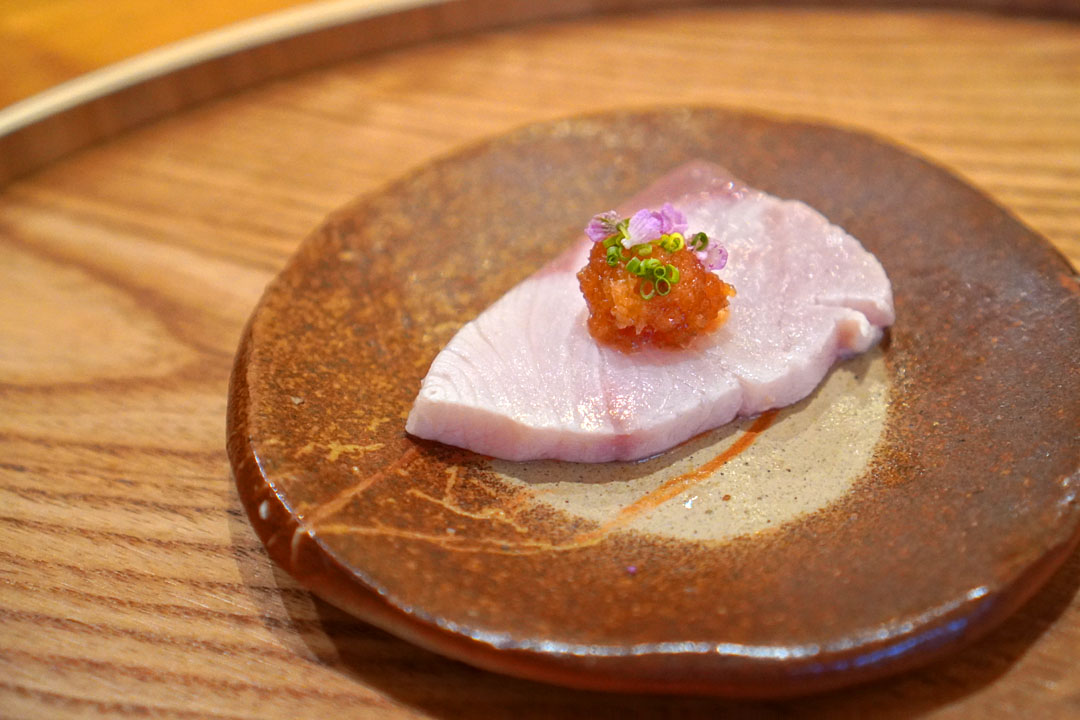
3: Buri | Kind yellowtail
Japanese amberjack was prepared in a shabu-shabu-like fashion, giving the fish a satisfyingly meaty, rare, slick, half-cooked texture. At the same time, the piquant savor of ponzu and dashi imparted further potency, while the daikon and hana hojiso lightened the mood.
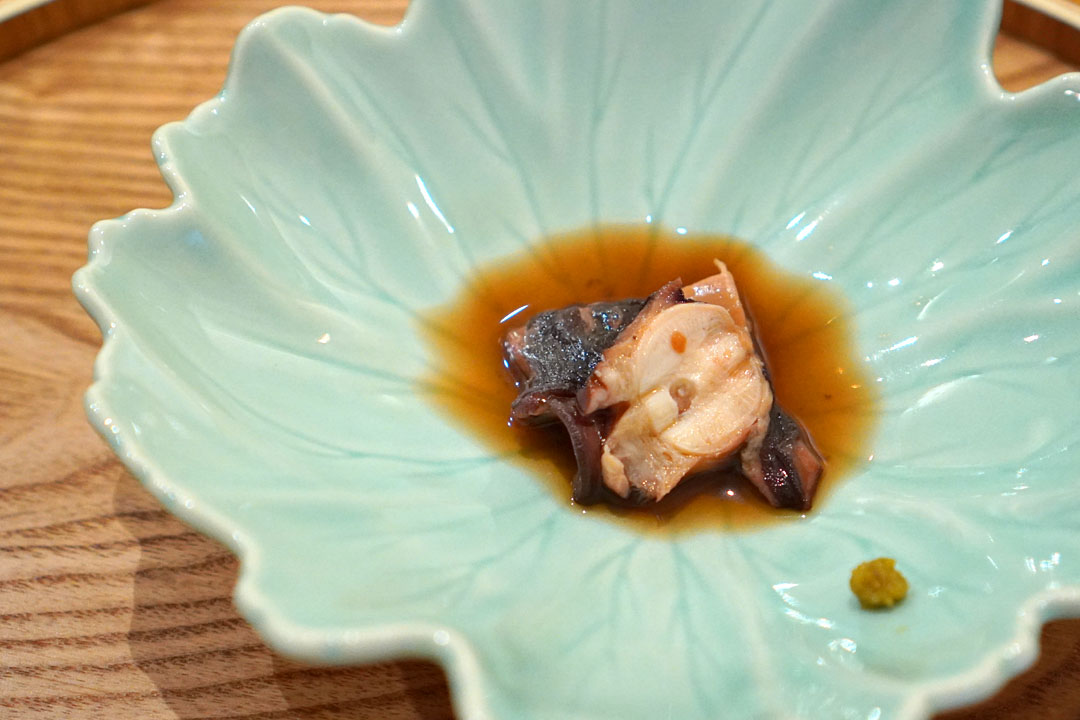
4: Ni-tako | Hokkaido Octopus
For our nimono course, octopus was simmered for three hours with hojicha, giving it a super tender consistency and some utterly savory, dark-toned flavors. Given the richness of the octo, the yuzukosho served a crucial function as a sour, spicy accent piece.
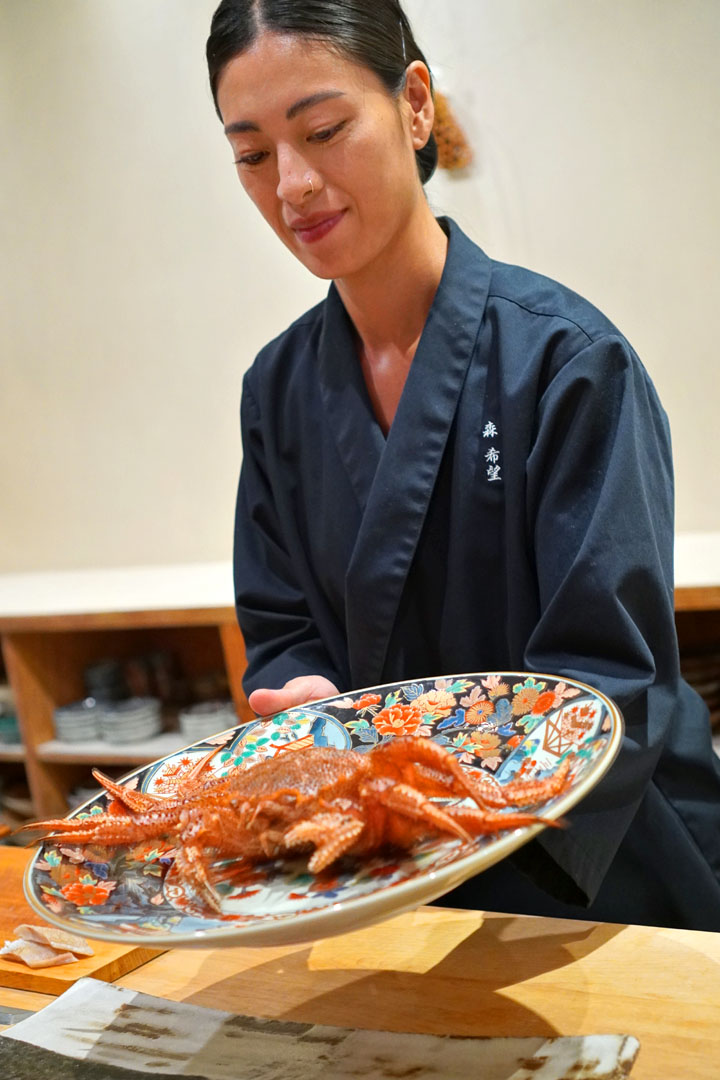
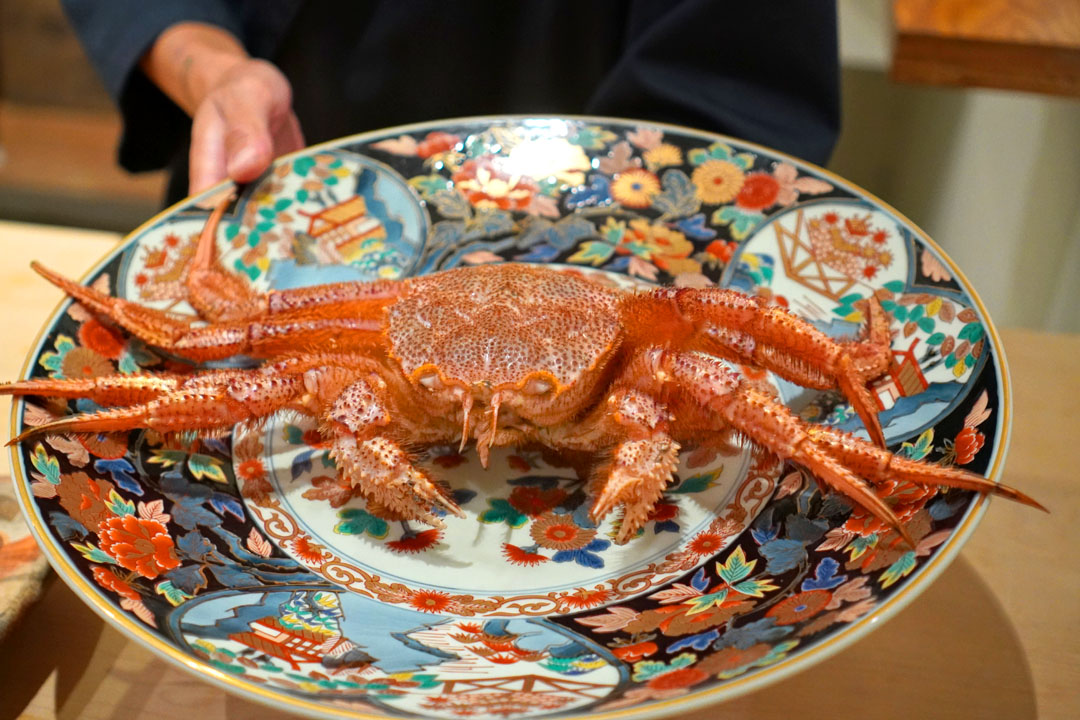
At this point, Nozomi-san brought out a live horsehair crab, which would be utilized in a couple of our later courses.
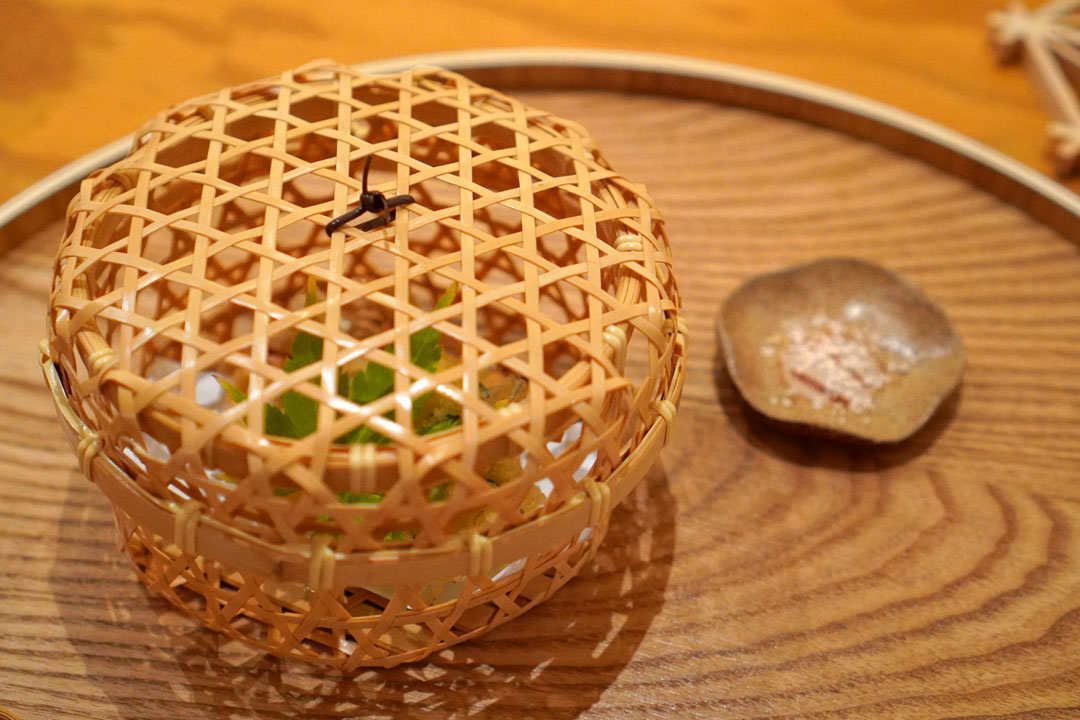
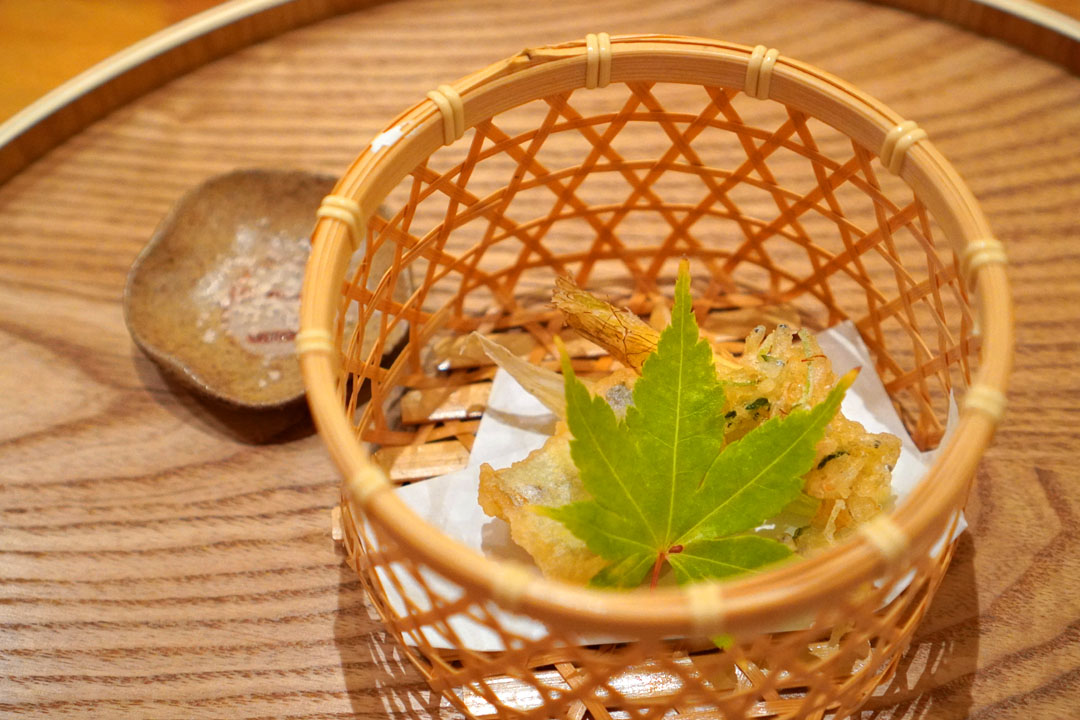
5: Tachiuo tempura, Shirasu kakiage | Belt fish, whitebait
The last of our zensai brought a trio of tempura. I started with the beltfish, which featured a soft, creamy interior and mild taste that really opened up with a dab of salt. On the other hand, the kaki-age was a whole different story in terms of mouthfeel, and was also more assertive flavor-wise. Last up was the corn, which I found wonderfully sweet, with a delightfully crunchy texture to boot.
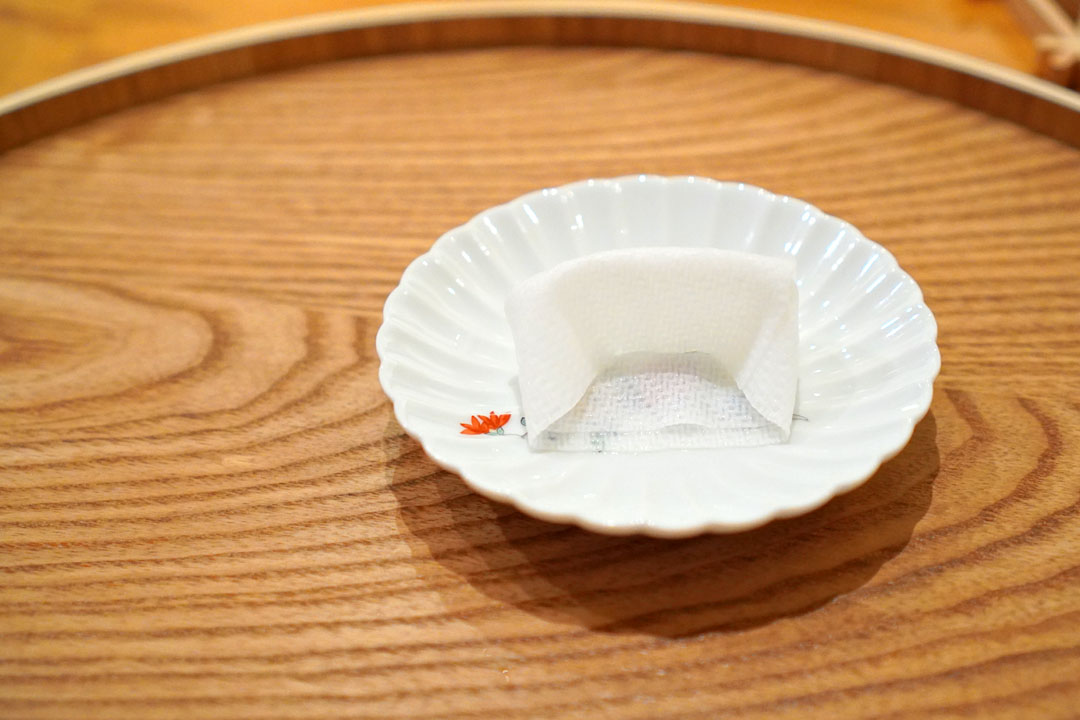
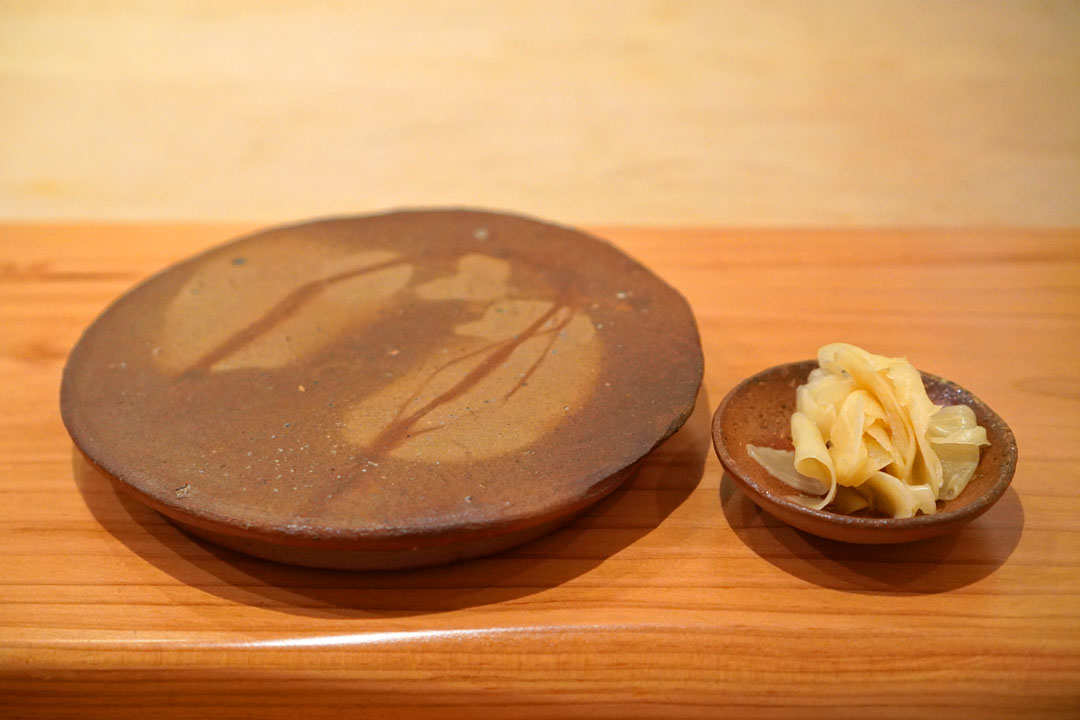
The arrival of a finger napkin and ginger signaled the start of the nigirizushi portion of our meal.
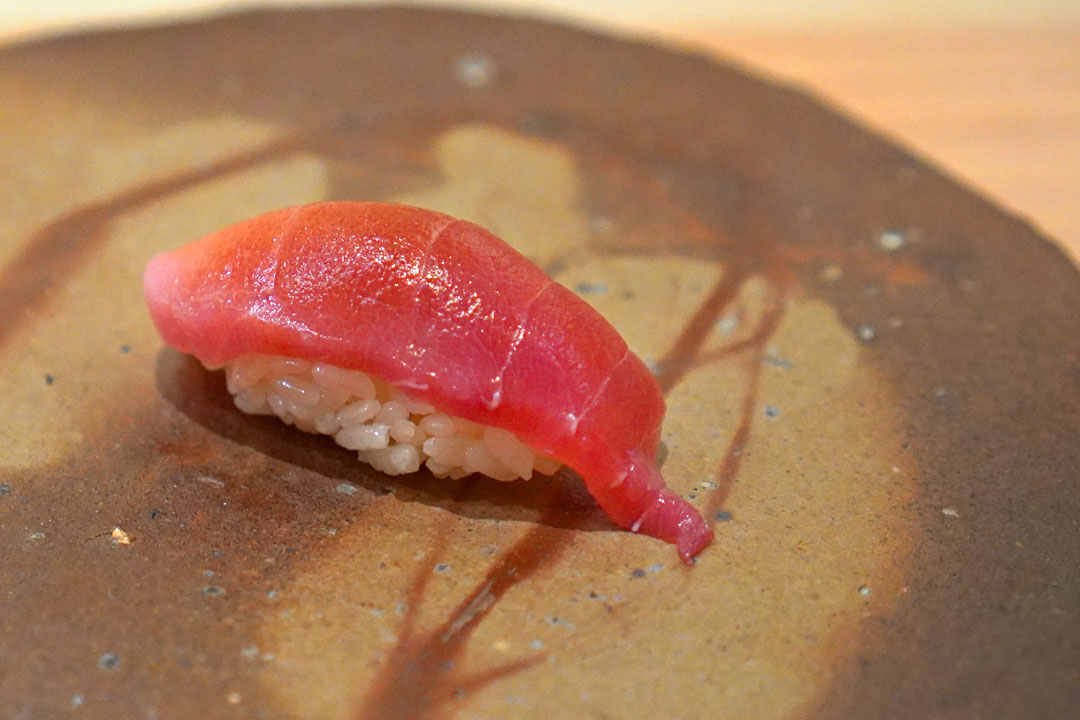
6: Bluefin tuna Chu-toro
Chef Mori kicked things off with a supple slice of savory-sweet chutoro, set atop a pillow of mildly-seasoned, firm-ish rice.
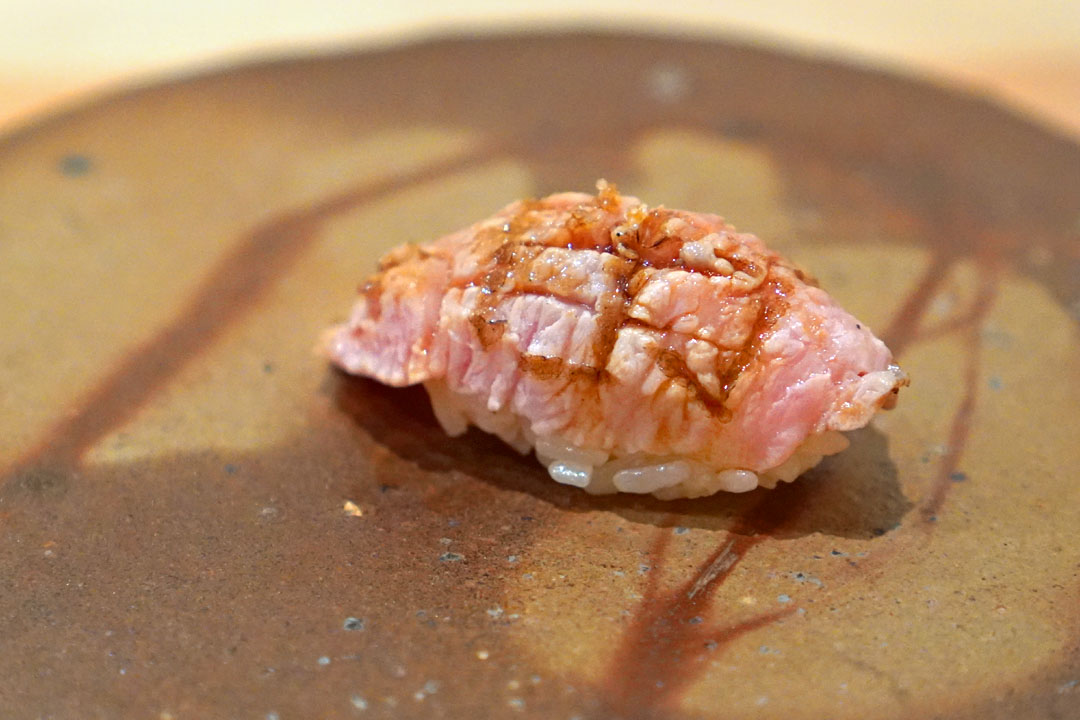
7: Bluefin tuna O-toro
Kamatoro isn't something you encounter too often around these parts, so it was a treat to see it on the menu tonight. The tuna collar arrived lightly seared, giving the cut a wonderful astringency to offset the sheer richness and fattiness of the fish, and as expected, the shari was crucial for balance. A bit of a showstopper.
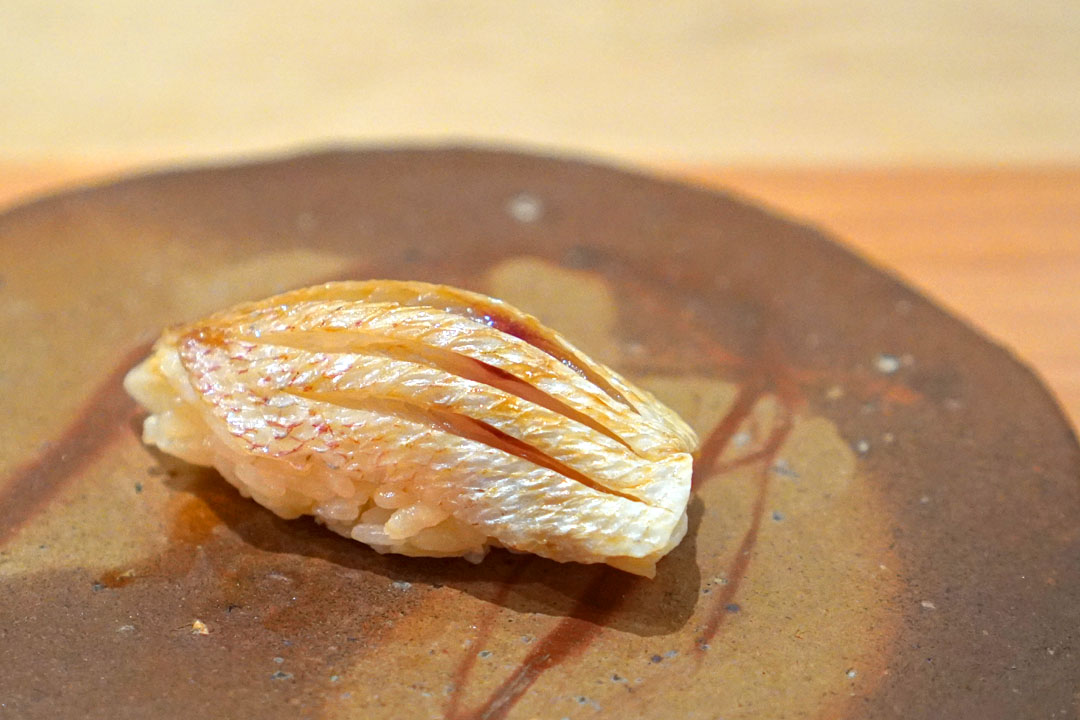
8: Kasugo-dai | Baby snapper
Somehow, the kasugodai was much more compelling than most. I loved its cool brine and how that played with the tangy, almost funky nuances present.
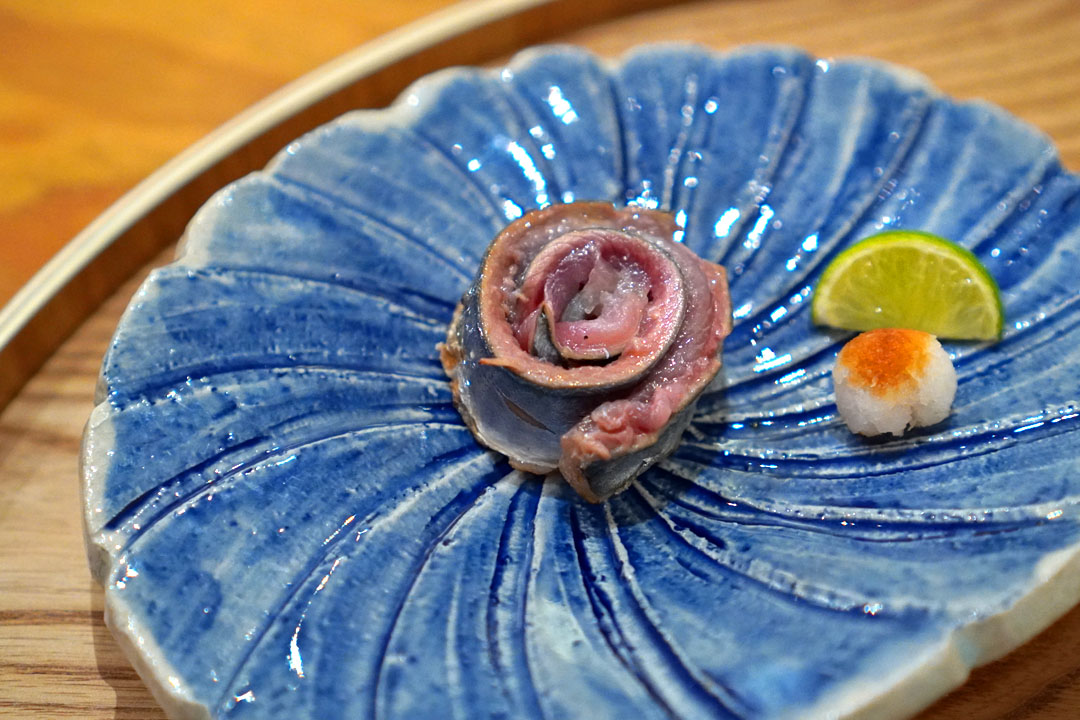
9: Sanma | Pike mackerel
Rolled mackerel pike had a wonderful smokiness and salinity that was deftly evened out by the citrus and grated daikon.
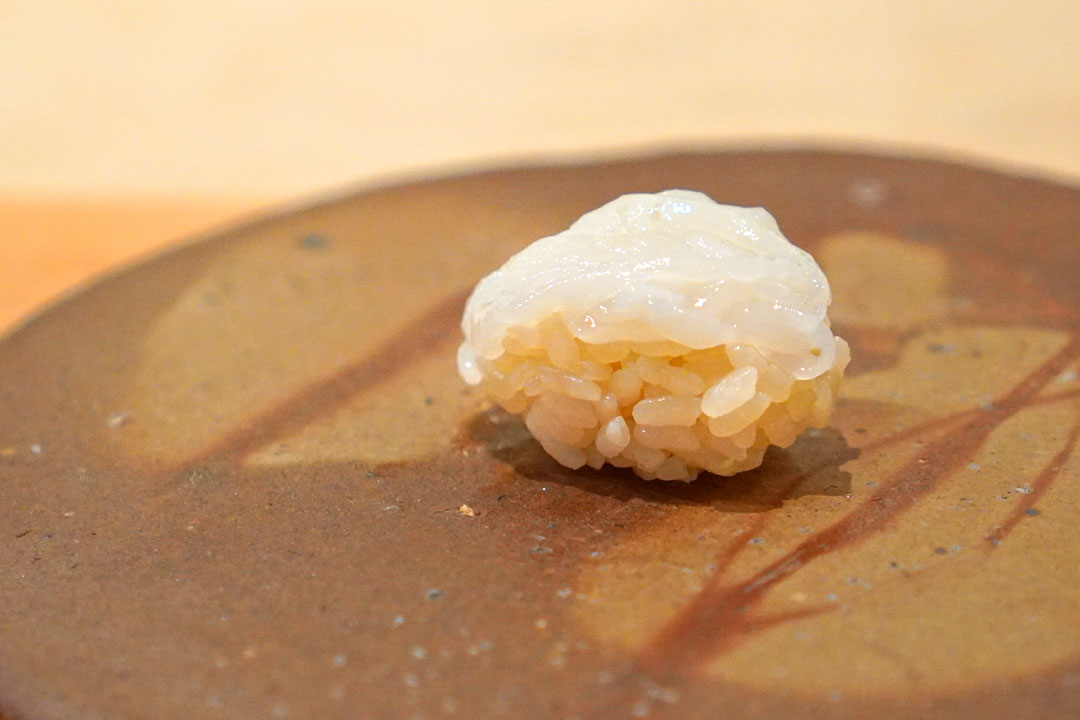
10: Shiro Ika | Swordtip squid
The squid had more depth of flavor than you typically find, which I appreciated, and its tender texture was great when juxtaposed against the relative firmness of Noz-san's rice here.
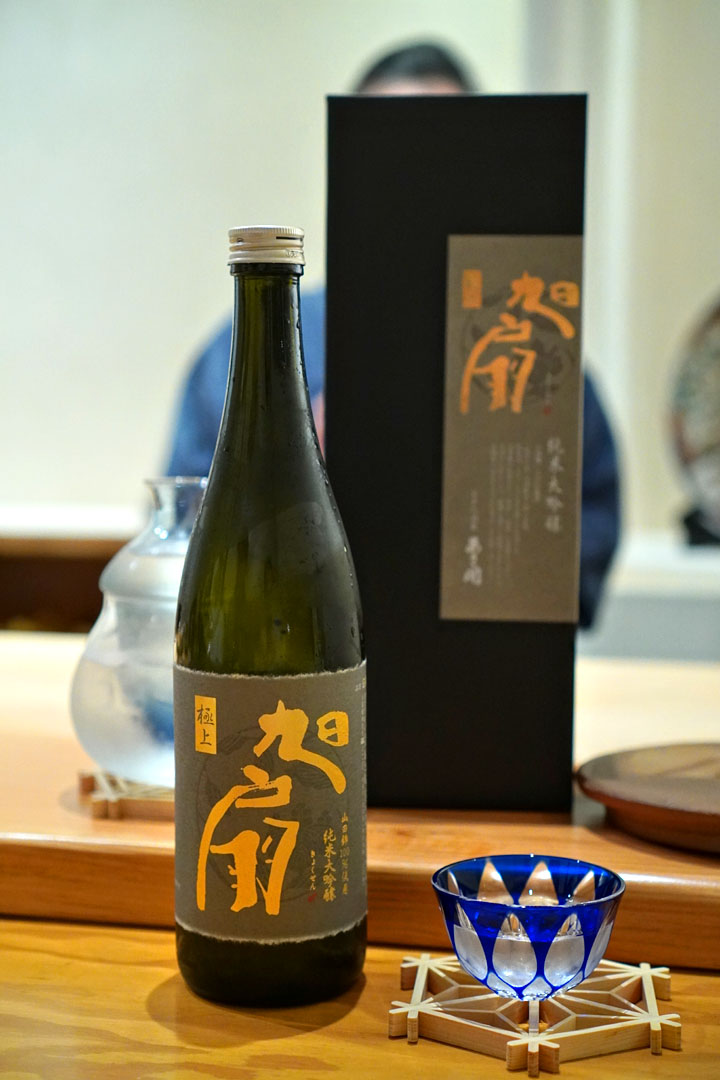
At this point, we'd run out of wine, and thus ordered a bottle of the Asabiraki "Kyokusen""極上 旭扇" [$350]. Coming to us from Morioka in Iwate Prefecture, the junmai daiginjo-class sake displayed some pretty remarkable aromas of anise commingled with banana bubble gum. This was smooth and sweet on the tongue, with notes of flowers and melon fruit backed by countering elements of ricey umami and heat. Lovely.
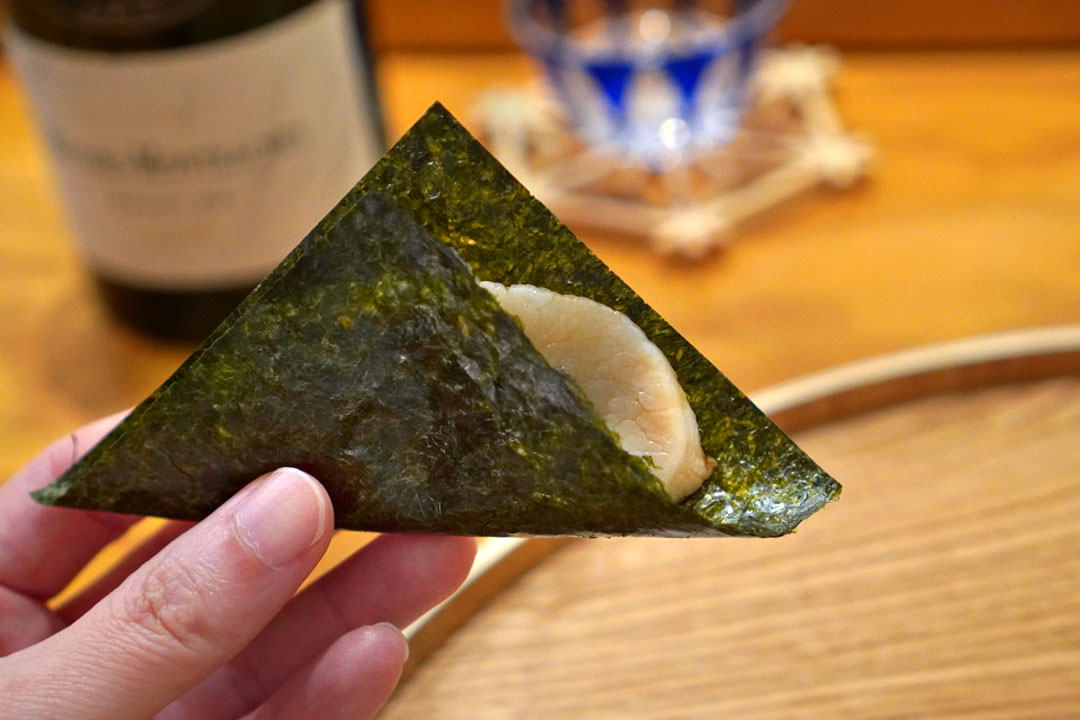
11: Taira-gai | Penshell
I'm quite a fan of pen shell, and this was arguably the best I've had. I loved how its considerable sweetness married with the smoky, grassy flavors of the seaweed, while this chili-like heat came in and served as the perfect finishing touch. Excellent texture on the clam, too.
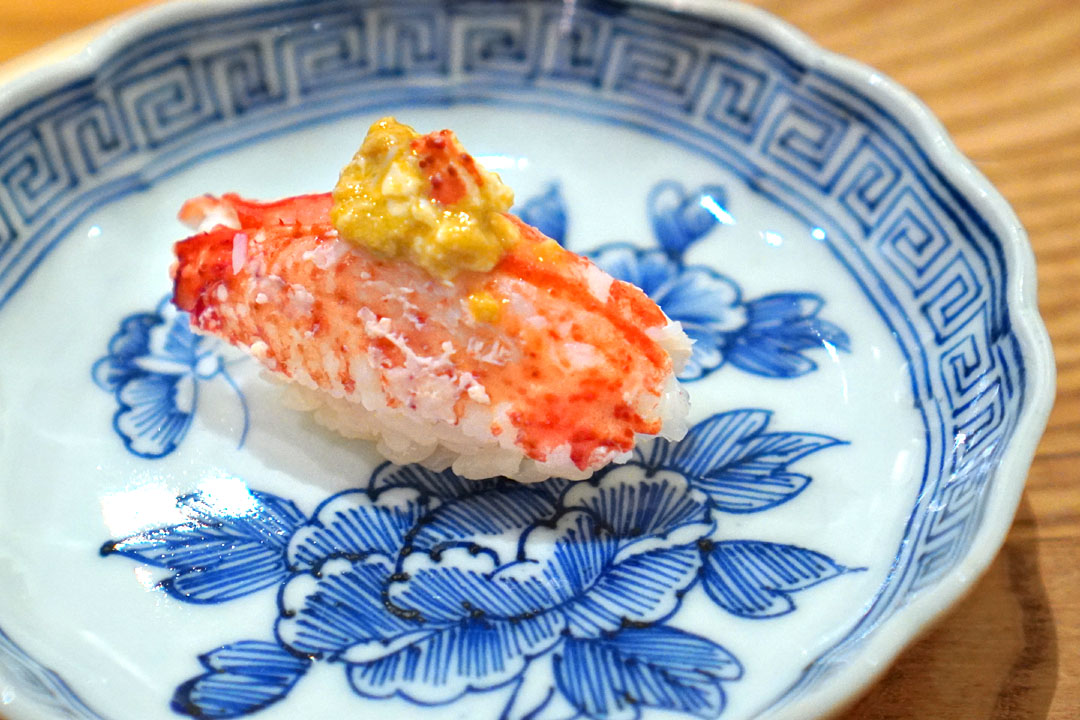
12: Hokkaido Kegani | Hairy crab
The horsehair crab from above was served in nigiri form, and revealed this amazingly pure, concentrated sweet salinity that was further boosted by the depth of its kanimiso-based condiment. This was a contender for the best hairy crab I've tasted, a sentiment shared by one of my fellow diners.
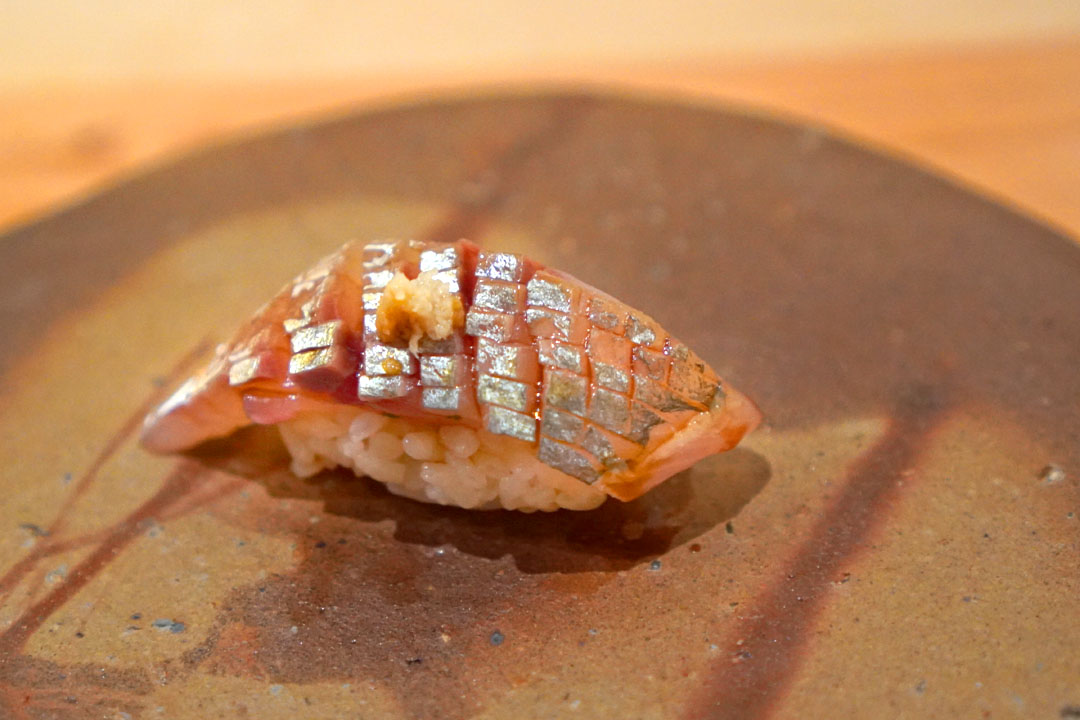
13: Wild Tsuri-Aji | Jack mackerel
A beautifully scored cut of horse mackerel had this slick, semi-firm consistency that I adored, while its super clean, focused, slightly sweet flavors worked seamlessly with the spicy kick of ginger.
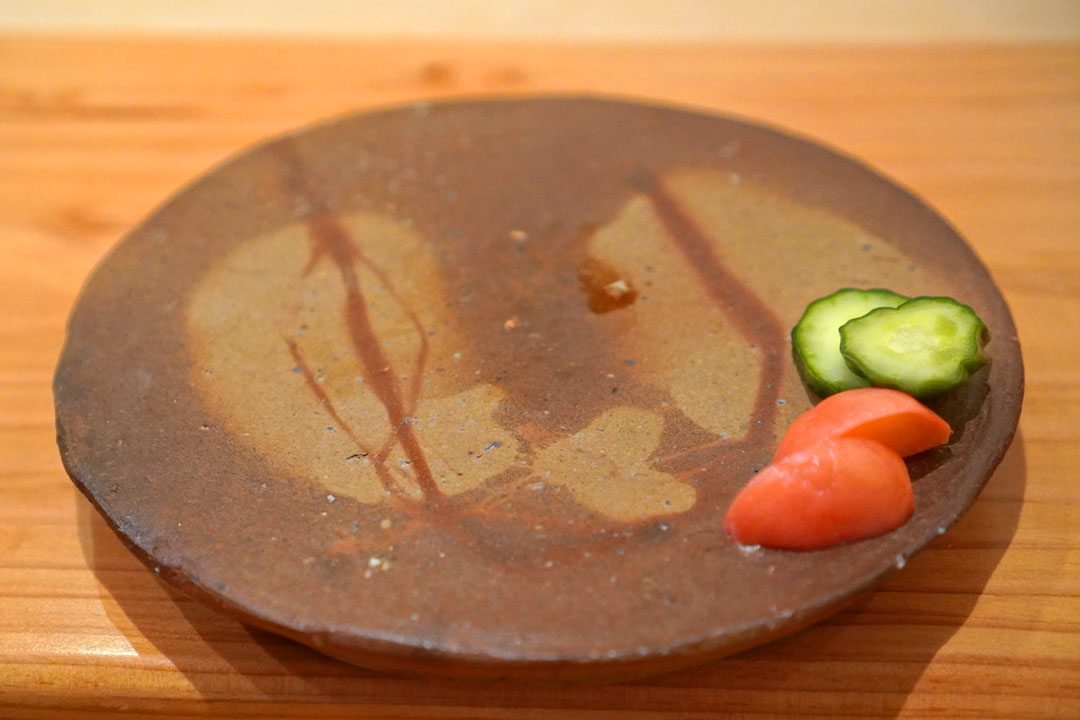
14: Oshinko | Japanese pickle
Two types of konomono were then provided: cucumber pickles that reminded me of salted watermelon, and crisp, tangy radishes that worked great as a palate cleanser.
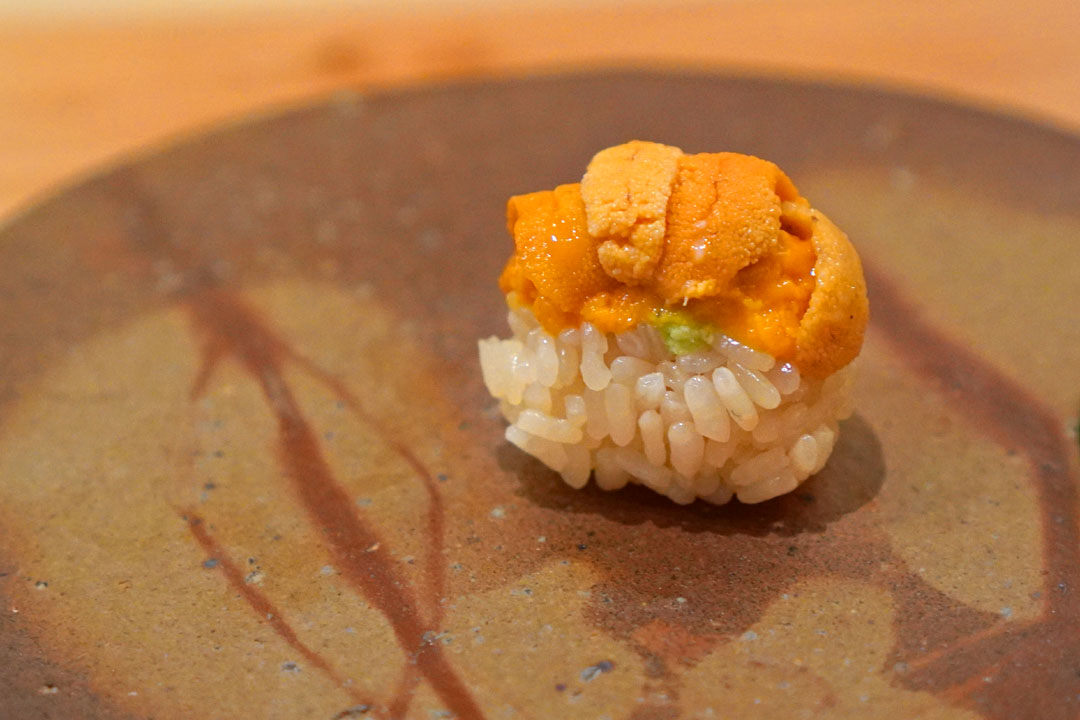
15: Hokkaido Uni
The sea urchin was on point, its signature sweetness and lingering brine meshing easily with the rice, which was seemingly fuller-flavored in this application.

16: Akami | Bluefin tuna
Lean tuna married all the delectably umami-laden tastes I was looking for with the sting of wasabi, all while the rice was key in moderating the flavors at play.
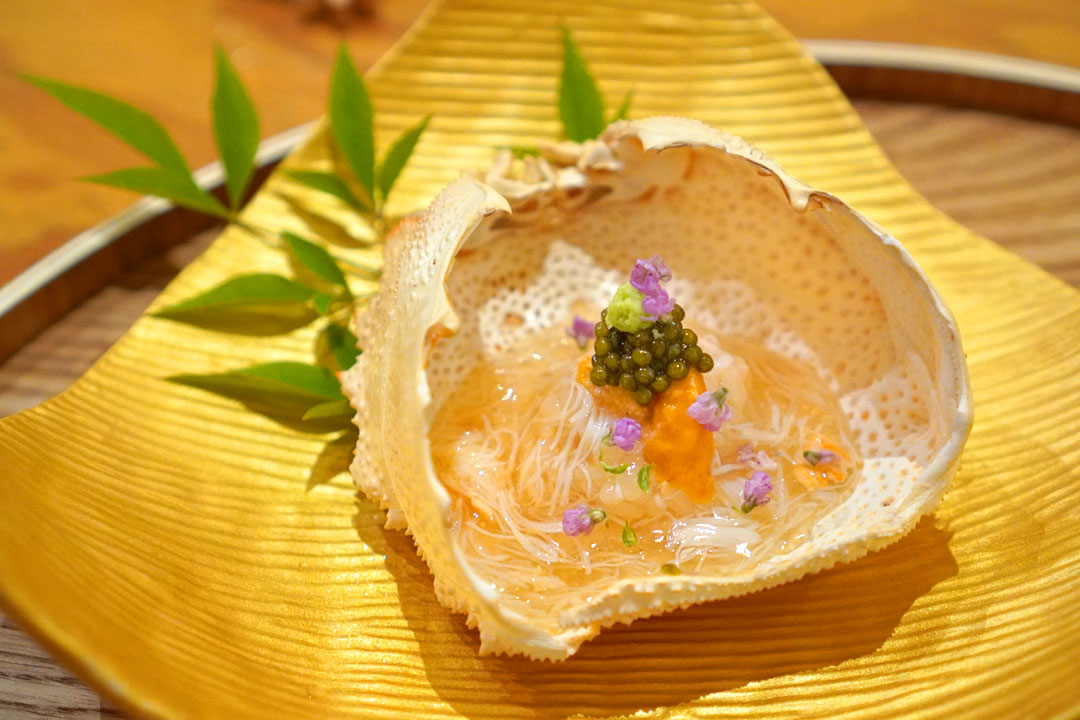
17: Kegani Ankake | Hairy crab
Our second presentation of horsehair crab was also a winner, combining the crustacean's sweetness with a viscous, smoky, mouthwateringly savory sauce.
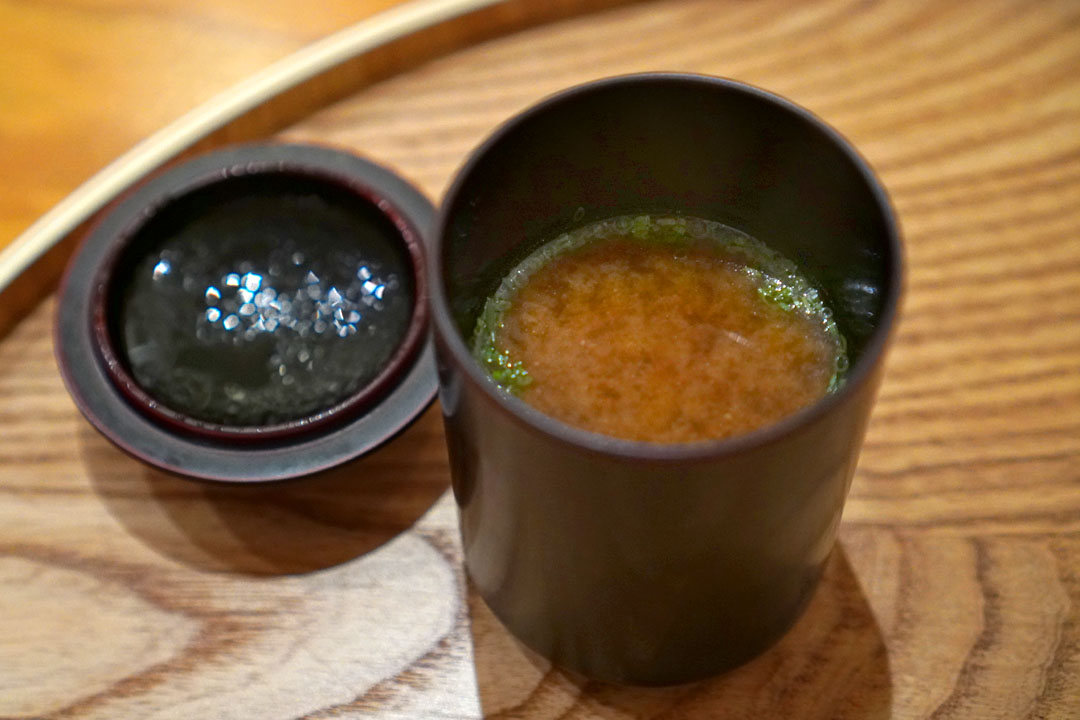
18: Akadashi | Red miso soup
This akamiso-based miso soup was headier and heartier than most, and made for some cozy sipping.
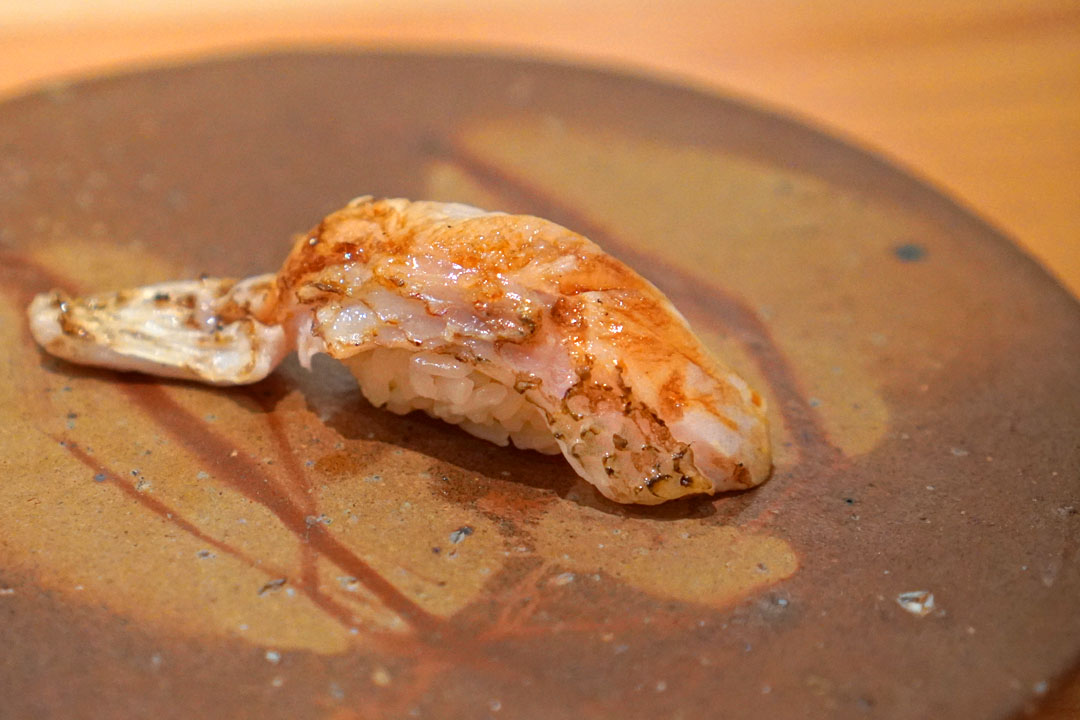
19: Nodoguro | Blackthroat Seaperch
Given my proclivity for akamutsu, it was great to see it on offer tonight. Served lightly charred, the neta showed off a pleasing temperature contrast, and I was smitten by how well its smoke and sear coalesced with the fish's robust-yet-elegant brine.

20: Toro-taku hand roll | Bluefin tuna with Japanese pickle hand roll
The pairing of crisp, sour strips of takuan with fatty tuna is a winning combination indeed, one further enhanced by that saline seaweed wrapper.
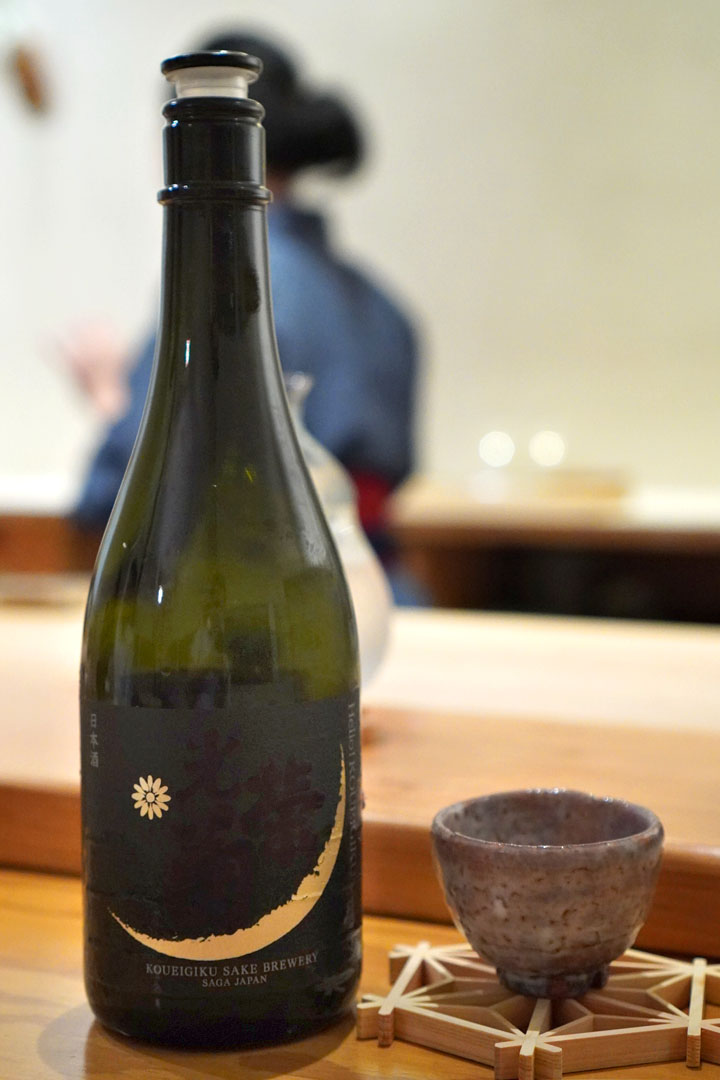
Our final beverage was the Harujion, Muroka nama genshu, Saga "光栄菊 佐賀県産" [$100], brewed by Koueigiku Shuzo out of Saga Prefecture. The sake leaned bright and spritzy on the nose, with lots of juicy fruit all over the place. I found this slightly effervescent on the palate, its sweet flavors of melon and cotton candy countered by just a touch of earth, making this an easy-drinker for sure.
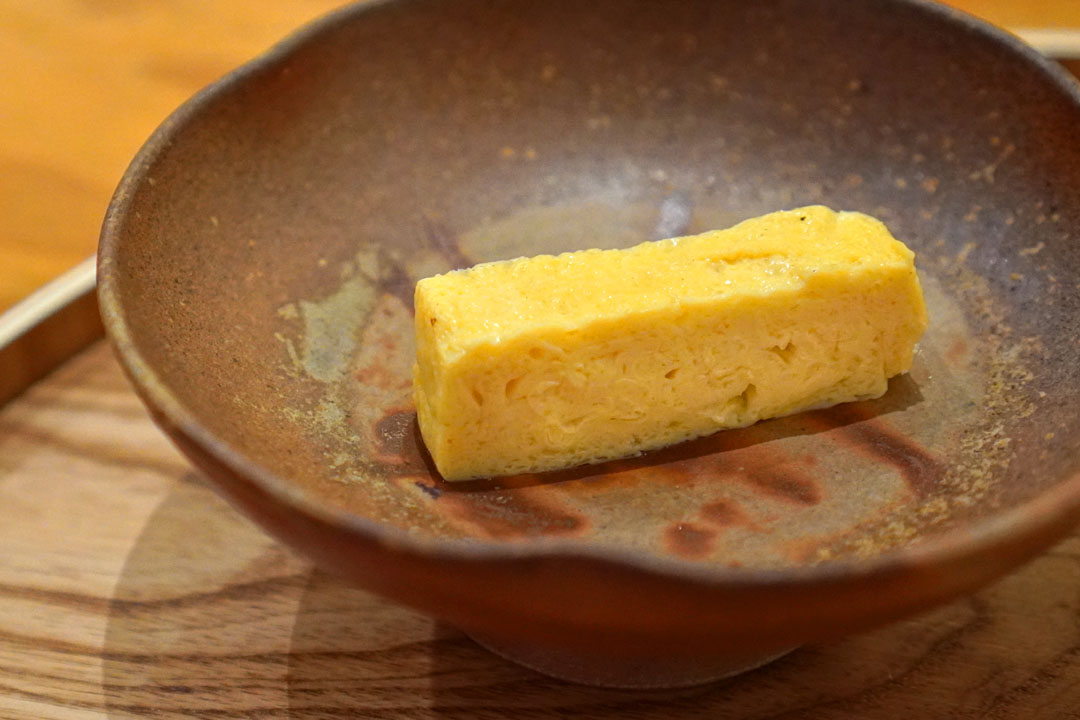
21: Dashimaki Tamago | Japanese omelet
This dashi-infused tamagoyaki was one of the better ones I've tasted in a while. I was of a fan of its supple, somewhat slippery consistency, as well as that layer of umami imparted by the stock.
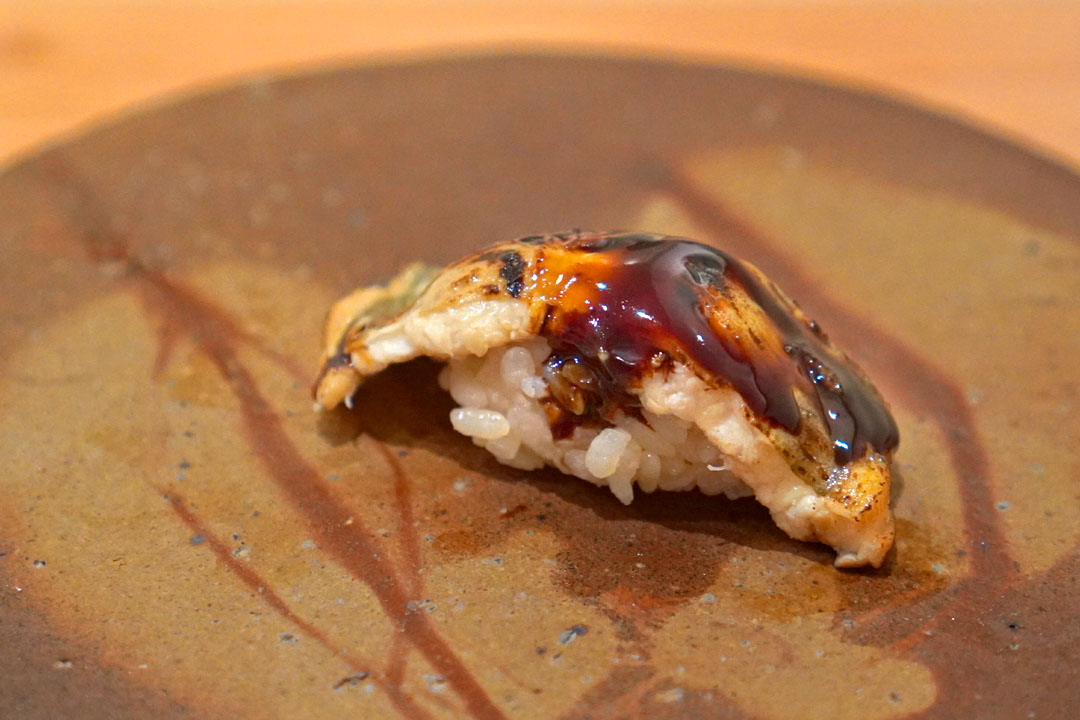
22: Anago | Sea eel
Conger eel ate wonderfully soft, sweet, and savory, and served as a fitting end to our parade of sushi.
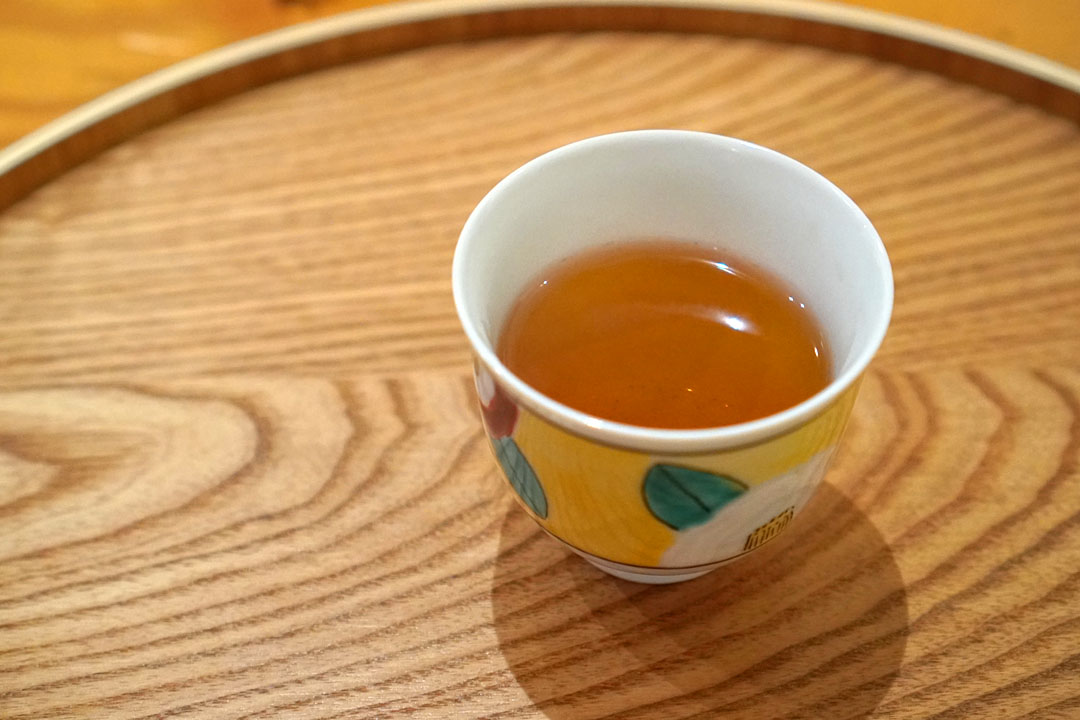
A roasty cup of hojicha then appeared before us.
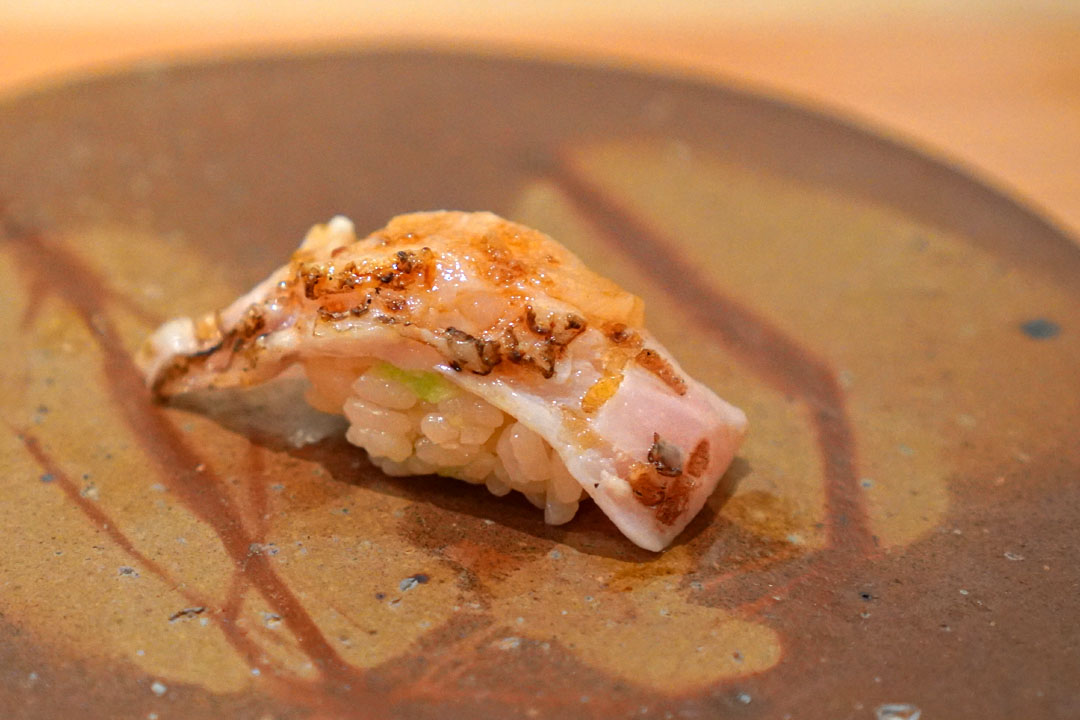
Supplement: Nodoguro [$18.00] | Blackthroat Seaperch
We weren't quite full at this point, so we requested an extra portion of rosy seabass, and its fantastic interplay of smoke and fat was even more apparent this time around.
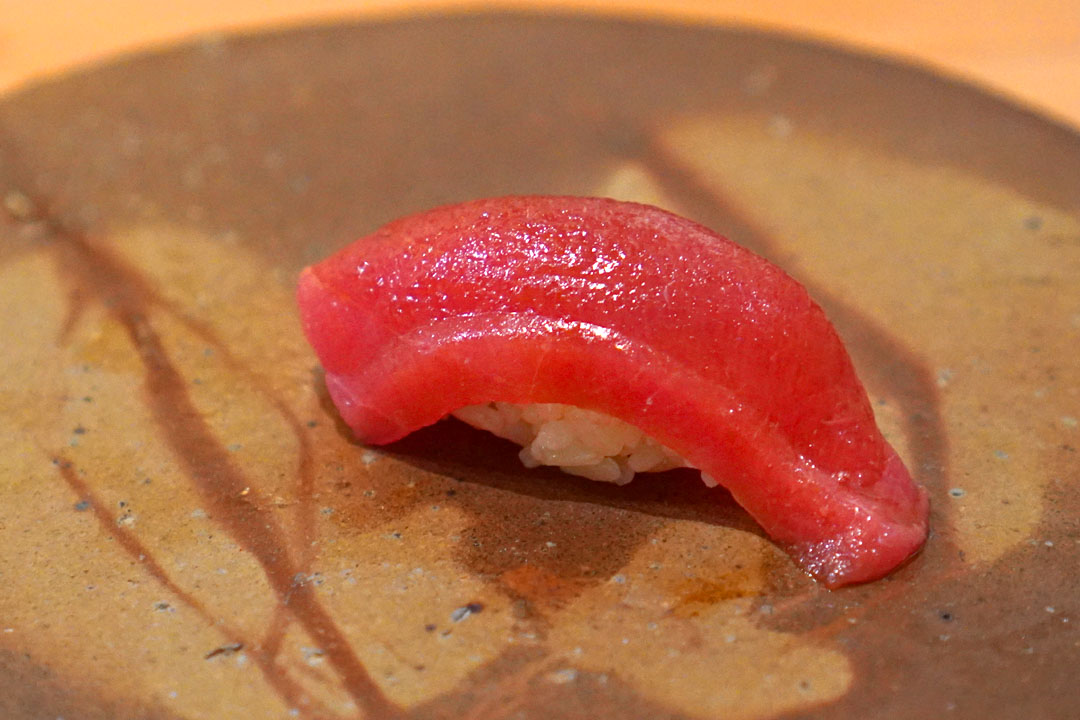
Supplement: Akami [$15.00] | Bluefin tuna
This was followed by an extra serving of tuna, which seemed to more keenly emphasize the back-and-forth between soy and wasabi.
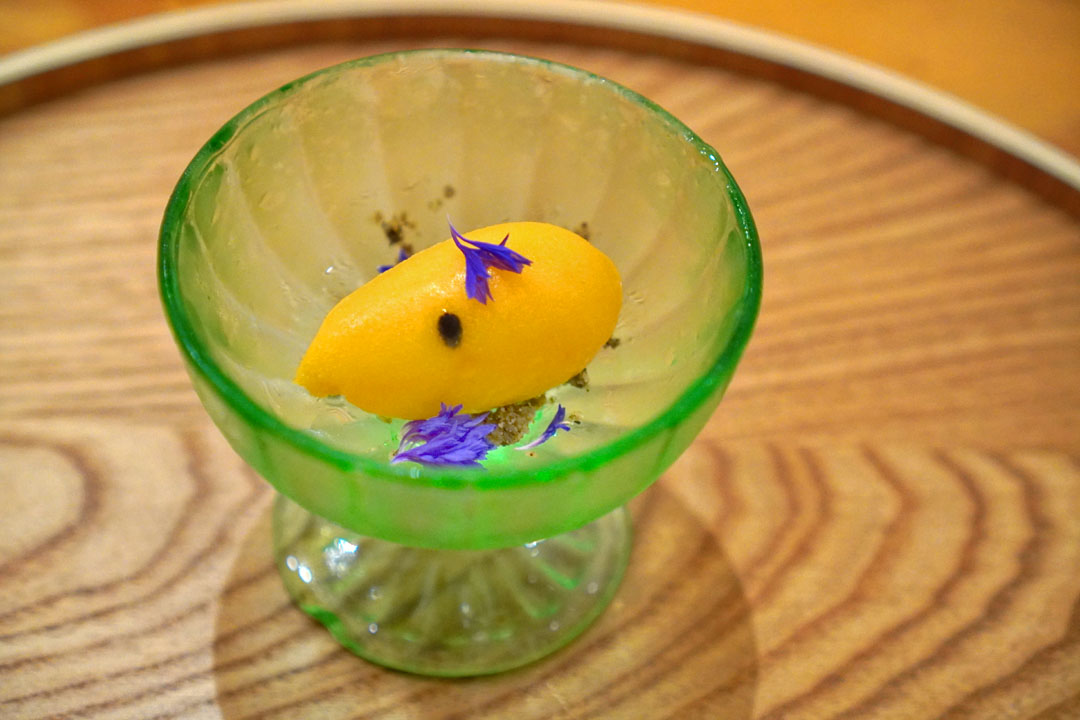
23: Passion fruit with Hoji-cha crumble
A refreshing, invigorating passion fruit sorbet was given a nutty, roasty boost from the hojicha crumbles.
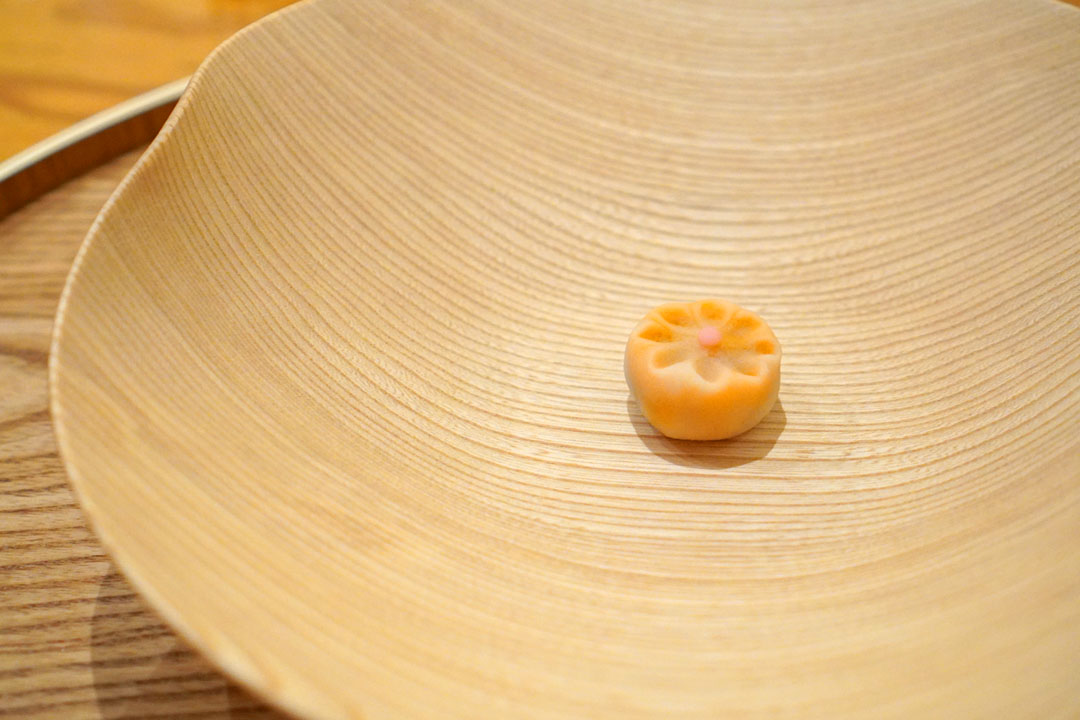
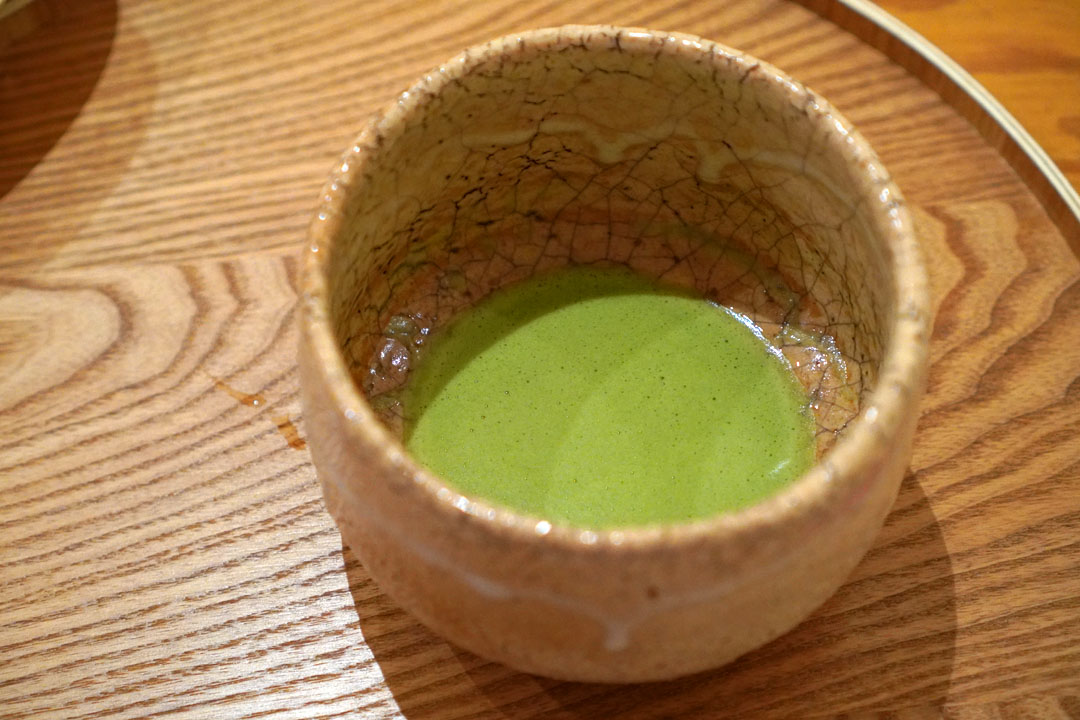
24: Wagashi with Kyoto Matcha
Our meal concluded a lone confection, sticky to the bite and loaded with sweet black sesame flavors that paired like clockwork with the bitter, grassy nature of green tea.
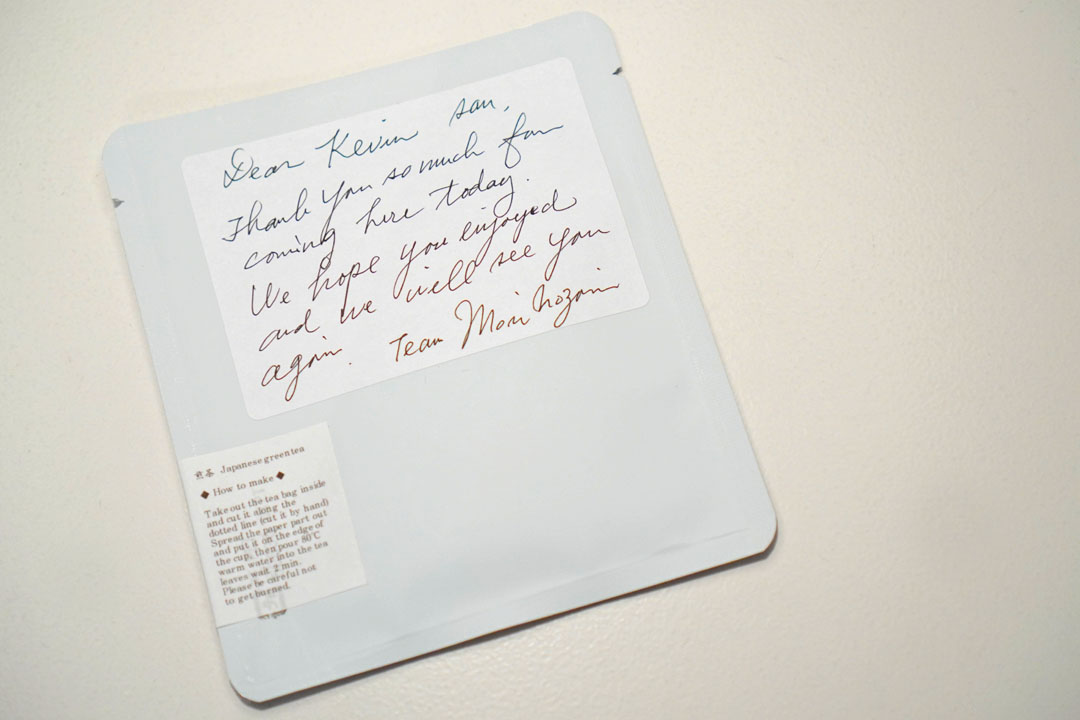
A packet of green tea served as our parting gift.
Make no mistake, the sushi at Mori Nozomi was the finest I've had all year, which is a bit remarkable given how relatively new Mori-san is to cooking. I don't think it's a stretch to assume that she's a fast learner. The crux for me is how she was able to infuse her own personality into the food, giving it a certain je ne sais quoi that made the meal stand out from the numerous other omakase options in SoCal. I didn't have any qualms about the service from the Chef and her team (Megumi and Yuko), either, and overall, I must come to the conclusion that this place is a splendid addition to LA's sushi landscape, and a worthy successor to take over this storied address. A must-try for all you sushi aficionados out there.

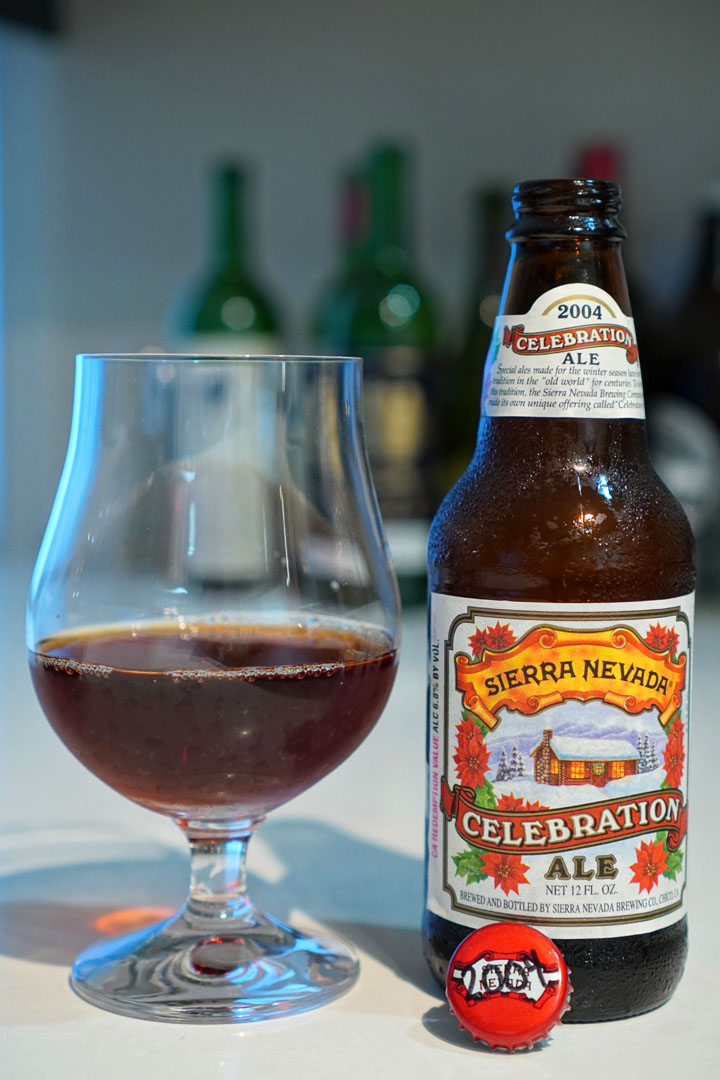
Prior to dinner, my dining party convened to enjoy a couple of 20-year-old beers that I had been cellaring, and in general, we were impressed by how well both of 'em held up:
- 2004 Sierra Nevada Bigfoot– A barleywine-style ale, this one had a nose rife with dark fruit, with a sugary, almost candied backing. On the palate, the beer was ridiculously smooth, with loads of malty sweetness offset by oxidative elements and a still-present undercurrent of hoppy astringency.
- 2004 Sierra Nevada Celebration Ale– Aromas here were super malty, with layers of sugary, funky fruit. As was the case with the Bigfoot, the mouthfeel on this was ultra silky, while taste-wise, things were more restrained, both in terms of hop bitterness and malt sweetness, but there was still this plum-like fruitiness at play, along with touches of oxidation.